
Ferdinand Joseph Lamothe "Jelly Roll" (Mouton) Morton (October 20, 1890 - July 10, 1941) | |||
 Selected Compositions - Earliest Confirmed Year Selected Compositions - Earliest Confirmed Year | |||
|
1915
[Original] Jelly Roll Blues [Chicago Blues]Superior Rag 1918
Frog-I-More Rag [Froggie Moore][Sweetheart o' Mine] 1923
Grandpa's SpellsWolverine Blues [The Wolverines] [1] Kansas City Stomp[s] The Pearls Mr. Jelly Lord Big Foot Ham [Big Fat Ham] [Ham and Eggs] Muddy Water Blues[?] Mamanita King Porter Stomp Shreveport Stomp Chicago Breakdown [Stratford Hunch] New Orleans Blues [New Orleans Joys] [Low Down Blues] [Monrovia] London [Cafe] Blues [Shoe Shiner's Drag] (My Home Is In a) Southern Town Deuces Wild Any Ox 1924
Bucktown BluesMidnight Mama [Tom Cat Blues] 1925
Milenberg Joys [2,3]Black Bottom Stomp [Queen of Spades] 1926
Sidewalk Blues [Fish Tail Blues]The Chant Fat Meat and Greens Dead Man Blues [4] Cannon Ball Blues [5,6] Stash that Cash [7] State and Madison: A Busy Stomp [7] Windy City Blues [7,8] 1927
Jungle BluesWild Man Blues [Ted Lewis Blues] Hyena Stomp Billy Goat Stomp 1928
Buffalo Blues [Mister Joe]boo [Gold Fish Blues] Low Gravy Honey Babe Georgia Swing Red Hot Pepper Sweet Anita Mine Deep Creek 1929
Seattle HunchPep Frances [Fat Francis] Freakish Tank Town Bump Down My Way Burnin' the Iceberg Pretty Lil New Orleans Bump Try Me Out Turtle Twist Smilin' the Blues Away Mississippi Mildred Courthouse Bump Sweet Peter Little Lawrence Mint Julep I Hate a Man Like You Don't Tell Me Nothin' 'Bout My Man My Little Dixie Home That's Like it Ought to Be 1930
Mushmouth ShuffleFussy Mabel Each Day If Someone Would Only Love Me That'll Never Do Croc-A-Dile Cradle Pontchartrain [Blues] [as Ponchatrain - sic] I'm Looking for a Little Bluebird Oil Well Primrose Stomp Harmony Blues Load of Coal Crazy Chords Strokin' Away Blue Blood Blues 1931
Dixie Knows [9]Fickle Fay Creep [Soap Suds] 1932
Gambling JackOa We E |
1933
Jersey [Jersey Joe]1938/c.1938 - LoC
The Finger Breaker [Finger Buster]Sweet Substitute If You Knew How I Love You The Perfect Rag [Sporting House Rag] Indian Song Moi Pas Taimez Ga Georgia Skin Spanish Swat Organ Interlude The Naked Dance [10] Mamie's Blues [219 Blues] [11] Why? [11] 1939
Don't You Leave Me Here [I'm AlabamaBound] The Crave Albert Carroll's Blues Good Old New York [World's Fair Song] [12] We Are Elks [12] We Will Never Say Goodbye [13] Winin' Boy Blues [Winding Boy] Anamule Dance [Animule] Michigan Water Blues 1940
Big Lip BluesDirty, Dirty, Dirty Get the Bucket Shake It Swinging the Elks Unpublished or Uncertain
Aaron Harris (Was a Bad, Bad Man)Alabama Nights Benny Frenchy's Defeat Bert Williams [The Pacific Rag] Betty Buddy Bertrand's Blues Buddy Bolden's Blues Buddy Carter Rag Cadillac Rag [?] C'etait N'autf' Can Can Card Dealer's Song [?] Crazy Chord Rag [Boogie Woogie Blues] Creepy Feeling Dear Ole Lonnon Discordant Jazz Exit Gloom Fast Ragtime Game Kid Blues Gan Jam Golden Wedding [Shreveport Stomp Waltz] Hen House High Brown Baby Mine [14] Hog Function Honky Tonk Music [Blues] Il Trovatore (The Miserere combined w/the Anvil Chorus) Jazz Jubilee Jelly Roll Morton's Scat Song La Paloma into Blues Levee Man Blues [Levee Rambler Blues] Melody with Break Melody with Riff My Darling is the Only One for Me New York Town One Straight Melody Prologue Opening Sammy Davis' Ragtime Style A Slow Jazz Tune Smart Set Stomp Stop & Go Stratford Rag [same as Hunch?] Sugary Superior Rag Sweet Jazz Music There's a Sign on Her Window Tom Cat Stomp Try and Get It Twenty Four Hours of Love Every Day ZZ
1. w/Benjamin Spikes & John Spikes
2. w/Paul Mares & Leon Roppolo 3. w/Walter Melrose 4. w/Anita Gonzalez 5. w/Charlie Rider 6. w/Marty Bloom 7. w/Bob Peary & Charles Raymond 8. w/Jimmie Hudson 9. w/Mel Stitzel 10. from Tony Jackson 11. from Mamie Desdunes 12. w/Ed Werac 13. w/Paul Watts 14. w/Karl Kramer | ||
 Selected Discography Selected Discography | |||
| |||
 Known Rollography Known Rollography | |||
| |||
There are some musicians who come along and make waves either through their antics, their bravado, or their performance skills. Ferdinand "Jelly Roll" Morton was one of those individuals who managed to captivate fans and raise the eyebrows (and the ire) of other musicians through all three. In this instance, also, it is hard to peg him into a single genre, other than "Jelly Roll Style," given how different and distinctive both his performance and writing of rags and blues was. He left behind one of the more important looks at the origins of ragtime, at least in New Orleans and the South, through a series of remarkable conversations recorded in 1938 and 1939. However, it was his own music and unique style that propelled him to fame, pushed him into obscurity, then resurrected while ostensibly killing him at the same time. Although the most traditional source for his story was long held to be the widely regarded 1950 book by Alan Lomax, Mister Jelly Roll, research of the 21st century by the author and a number of his distinguished peers has turned up a much more accurate look at Morton's variegated story, of which a condensed version is presented here.
Early Life in New Orleans
The self-proclaimed inventor of Jazz and Stomp music, "Jelly Roll" Morton grew up in the right environment to absorb a variety of musical influences: New Orleans, Louisiana. He was born in New Orleans, Louisiana, out of legal wedlock (in a common law marriage) to Edward Joseph Lamothe (or Lemott) and Louise Hermance Monette (or Monett). The often-cited date of September 20 does not align with the official baptismal registry in New Orleans, which insists on an October 20 birth, so the latter will be accepted for this essay as the potentially most accurate accounting, even though Morton himself continued to write September 20 throughout his life. When he was around three or so, Louise left her situation with Lamothe and was soon married to William Mouton on February 5, 1894. Ferd would eventually adopt a variation of his stepfather's last name as his own, morphed into Morton.
Growing up on Frenchmen Street a bit outside of the French Quarter, Ferd was just a streetcar ride away from many New Orleans musical venues located in the Quarter and the Tremé, as well as downtown. Considered a true Creole, he was a mulatto, which created its own set of difficulties, as the darker communities did not always accept light skinned blacks, yet they were still too black for the white communities.
Ferdinand got past this by communicating through music. He learned guitar at age 7, and piano at 10. As of the 1900 census the family was located in New Orleans with Ferd's half-sister Eugénie Amède added to the home in late 1897. Another sister, Frances a.k.a. Mimi, arrived in mid-1900. Ferd moved out of the Mouton home the following year, residing with his godmother Laura Hunter (a.k.a. Eulalie Hécaud) for some time.
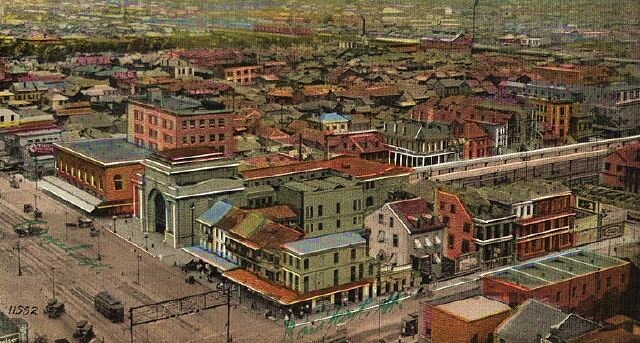 |
Ferd took piano lessons from local black schoolteacher Rachel D. Moment for an indeterminate period of time. Morton described her as "the biggest ham of a teacher that I've ever heard or seen..." However, with his innate talent he also likely absorbed a lot of the influence of other musicians playing in or near downtown New Orleans. Among those he later cited was Mamie Desdunes (a.k.a. Mary Celina Desdunes Dugue), who played a simple blues style due to a crippled right hand. He also mentioned Tony Jackson and Albert Carroll, and by some accounts claimed to have heard or possibly known the storied but somewhat notorious trumpeter Buddy Bolden. In his teens, Ferd became, be his own account, one of the most renowned pianists in Storyville, the red light district of New Orleans set up by alderman Sidney Story in 1897. There is some evidence, or lack thereof, to counter this bodacious claim, but there is little doubt that he spent some time either playing or listening to others play in the houses there. His later description of Tony Jackson playing a Naked Dance for the girls to show off their wares to the customers provides some credence to this probability. Another place he frequented was the Frenchman's Café where many New Orleans musicians played during and after hours.
In early 1904, Morton traveled to Saint Louis, Missouri, allegedly to attempt to play at the Lewis and Clark Centennial Exposition, likely on the mile-long amusement Pike, and to absorb local musical influences. There was a contest there in late February at Tom Turpin's Rosebud Saloon that Morton claims he demurred from due to the presence of some of the high-caliber pianists playing there. They included the champion of the event, Louis Chauvin, his friend Sam Patterson, Charles Warfield and Joe Jordan among others. Perhaps the point should be made that he was not yet 14 years of age played, which likely a bigger factor in the overall situation. Still, he soaked in the influences of this environment, learning more than just the music, but also the lifestyle of these pianists.
In 1906, Ferd's mother Lizzie died from a form of heart disease, leaving him more or less on his own at age 16, save for his godmother Laura. During this period Morton also learned more about performance with ensembles while traveling with Billy Kersand's Minstrels throughout the South and Midwest. He also met many musicians that influenced his style and his attitude, which might eventually be described as appropriately confident if mildly cocky. Among them were the aforementioned Tony Jackson, future composer Spencer Williams, John and Benjamin Spikes, Sammy Davis [a pianist and entertainer who was not same as the father of entertainer Sammy Davis, Jr., Samuel Davis, who was born in 1900, so too young], Arthur F. "Baby" Seals, and two gentleman that likely influenced the names of two of his important works, Porter King and Benson "Froggie" Moore. He also learned much of the reality of being a man of color away from his home town who which had been more tolerant of race, which was a hard lesson. During this time Ferd witnessed at least two disturbing lynchings of black men.
Building a Reputation - What's In a Name?
Still tethered somewhat to his godmother's home in New Orleans, it was there in 1910 that Ferd met Billy and Mary McBride, who had their own unique theatrical troupe called Mack's Merry Makers.
He played in their shows for a while, and during the tour frequented some of the brothels along the gulf coast of Louisiana and Alabama, possibly into Florida. Another actor and writer Ferd worked with was Sandy Burns, who for some time had traveled with Sammy Davis. It was allegedly Burns who either gave, or perhaps influenced the origin of, his unique nickname, "Jelly Roll." In the colloquial of the time, the connotation of that name was clearly sexual, and commonly referred to by both heterosexual and homosexual performers, including Jackson who was openly gay. Specifically, it was a reference to the male member, and not so much to a pastry. Just the same, Morton quickly adopted the name, and before the mid-1910s, while he still used Ferd from time to time, he started to enjoy billings as "Jelly Roll" Morton.
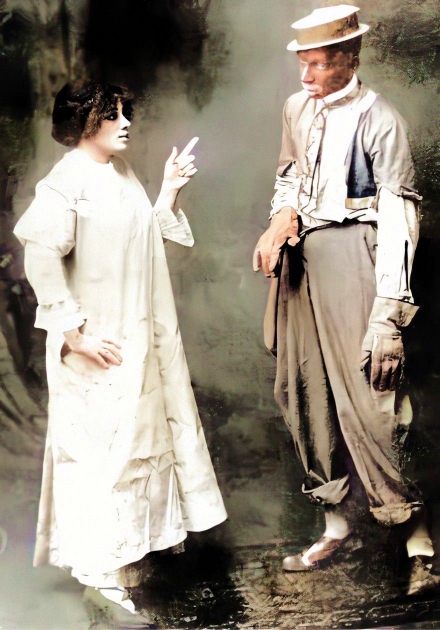 |
From this point on, Morton lived the ultimate itinerant pianist's life, traveling from town to town, carousing with local women, hustling in pool halls, and taking in the culture wherever he went. Lessons, or perhaps they should be called skills, that he learned in his early travels were how to be a successful pimp, a pool sharp and card sharp, and how to charm certain people while ticking off others, skills that served him well at various times. He was also a young man of contradictions with his own sense of questionable morality, being both a Catholic and a believer in the bayou culture of voodoo. Morton quickly learned how to turn any insecurity he had into a situation into bravado and vanity, often deflecting anything he thought might be a threat to him or his ego. [Note that these are collective observations noted by many of Morton's peers as well as his original biographer, Alan Lomax, but that they ring true overall through many of his actions, even if they cannot be completely construed as "fact."]
As a result of his constant travel, Morton was difficult to locate in the 1910 enumeration. Some of his movements of this period are suggested by combining his later recollections of who he played with and where with newspaper accounts of those people and events. In 1911 he was associated for a while with William Benbow's as they traveled the south, likely as both a pianist and a singer. The following year he was, at times, working with the Spikes brothers in the Midwest, with who would later pen one of his more iconic pieces. Later in the year and into 1913, he worked with the Jenkins and Jenkins troupe, which included Baby F. Seals, who had recently had his historic early blues piece Baby Seals Blues, arranged by Artie Matthews, published and distributed. Much of 1913 was spent in Texas, and Morton was listed in the Houston, Texas, directory for that year. Ferd had also taken on a vaudeville partner and singer, Rosa Brown, who was usually booked as Rosa Morton, although there was no official record found of them having married. They worked the vaudeville circuit from 1912 into 1914.
Early in 1914, Morton had been working with McCabe's minstrels when they were disbanded during a stay in Saint Louis, Missouri. From there, he and Rosa tried to find another troupe, and ended up in Kentucky by the spring, then back to the Dayton, Ohio area.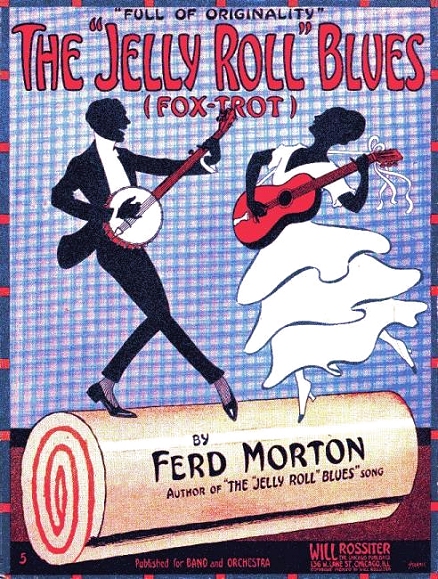 Ferd, now consistently billed as "Jelly Roll" or "New Orleans Jelly Roll," was receiving excellent reviews for his vivacious style, even when accompanying Rosa. He played a wide range of pieces from piano rags to classical pieces, and by this time, perhaps some of his own compositions. The couple, playing with other notable acts, also played Detroit, Michigan, and ventured down into Indianapolis, Indiana, then back east to Philadelphia, Pennsylvania. By late summer they were playing in Chicago, Illinois, where Ferd would later spend a considerable period of time. For 1915 he remained there through the remainder of 1914 and into 1915. There is a probability that he also did a short stint with the Memphis, Tennessee band of W.C. Handy, a composer whom he highly regarded at times, and derided in later years.
Ferd, now consistently billed as "Jelly Roll" or "New Orleans Jelly Roll," was receiving excellent reviews for his vivacious style, even when accompanying Rosa. He played a wide range of pieces from piano rags to classical pieces, and by this time, perhaps some of his own compositions. The couple, playing with other notable acts, also played Detroit, Michigan, and ventured down into Indianapolis, Indiana, then back east to Philadelphia, Pennsylvania. By late summer they were playing in Chicago, Illinois, where Ferd would later spend a considerable period of time. For 1915 he remained there through the remainder of 1914 and into 1915. There is a probability that he also did a short stint with the Memphis, Tennessee band of W.C. Handy, a composer whom he highly regarded at times, and derided in later years.
 Ferd, now consistently billed as "Jelly Roll" or "New Orleans Jelly Roll," was receiving excellent reviews for his vivacious style, even when accompanying Rosa. He played a wide range of pieces from piano rags to classical pieces, and by this time, perhaps some of his own compositions. The couple, playing with other notable acts, also played Detroit, Michigan, and ventured down into Indianapolis, Indiana, then back east to Philadelphia, Pennsylvania. By late summer they were playing in Chicago, Illinois, where Ferd would later spend a considerable period of time. For 1915 he remained there through the remainder of 1914 and into 1915. There is a probability that he also did a short stint with the Memphis, Tennessee band of W.C. Handy, a composer whom he highly regarded at times, and derided in later years.
Ferd, now consistently billed as "Jelly Roll" or "New Orleans Jelly Roll," was receiving excellent reviews for his vivacious style, even when accompanying Rosa. He played a wide range of pieces from piano rags to classical pieces, and by this time, perhaps some of his own compositions. The couple, playing with other notable acts, also played Detroit, Michigan, and ventured down into Indianapolis, Indiana, then back east to Philadelphia, Pennsylvania. By late summer they were playing in Chicago, Illinois, where Ferd would later spend a considerable period of time. For 1915 he remained there through the remainder of 1914 and into 1915. There is a probability that he also did a short stint with the Memphis, Tennessee band of W.C. Handy, a composer whom he highly regarded at times, and derided in later years.Working in Chicago with occasional travel to surrounding areas, Morton was no longer featured with Rosa, who had gone her own way, but worked with, among others, comedian and dancer William "Bojangles" Robinson. It was in Chicago that Morton's first big hit emerged in published form. His self-titled Original Jelly Roll Blues, issued in late 1915 by the well-established publisher Will Rossiter, created some issues before it was in print, in terms of arranging it in a way that was playable by the average pianist while retaining Morton's unique performance style. It would soon be made into piano rolls, recorded to disc, and even mentioned in a later song by Chicago composer Shelton Brooks, most famously as a line in his Darktown Strutter's Ball from 1917. "I'm gonna dance off both my shoes, when they play those Jelly Roll Blues, tomorrow night at the Darktown Strutter's Ball." By that time, Ferd's reputation for his playing and his vivacious personality, both good and suspect, was well established among his peers, and was gaining traction with the public.
According to some newspaper reports, as well as narrative from Barbary Coast pianist Paul Lingle, Morton made some of his first West Coast appearances during the latter part of 1915 at the Pan-American Exhibition (World's Fair) in San Francisco, California. As there was a similar event held in San Diego, California, near the Mexican border, at that time, it is possible that Morton also appeared in Southern California, but that was sketchy to confirm at best. Morton circulated around the Midwest in 1916, sticking largely to Indianapolis, Saint Louis and Chicago. However, he apparently enjoyed California, or at least found that the dearth of professional pianists of his caliber in the state provided him some golden opportunities, and eventually migrated out to Los Angeles in late 1916 or early 1917, possibly following the lead of bandleader William Manuel Johnson and his sister Anita who moved there at the same time.
Rise To Fame and Legend - The West Coast
One of the first locations where Morton set up was the Cadillac Café in Los Angeles in the spring of 1917, where he would play through most of the year. Before Morton came out, Los Angeles, California, was a rather unremarkable location during the bulk of the ragtime era. Very little published ragtime emerged from that city in the 1900s and 1910s, and most of the contemporary piano music of that period was presented on the vaudeville stage, in addition to popular songs and old favorites. The bulk of ragtime pianists and showmen were up north working the Barbary Coast section of San Francisco and the Bay Area, and even up into Seattle, Washington.
However, at the beginning of the jazz age, just before and around the time of Morton's arrival, there was surge of contemporary popular instrumental music in Southern California, which coincided to some degree with the growth of the film industry there, which was at a highly-accelerated pace from 1913 to 1920.
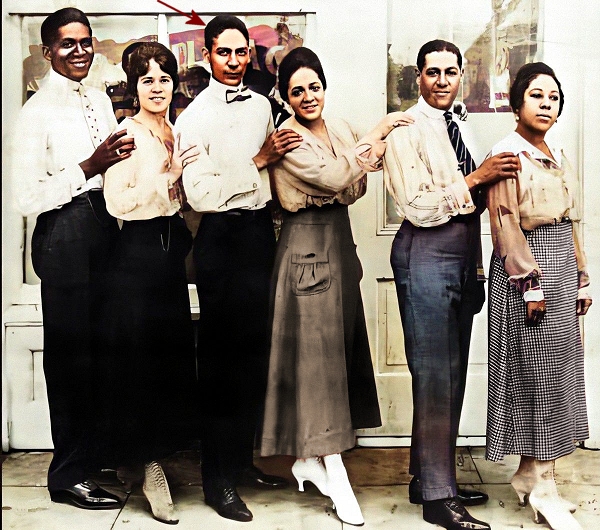 |
After several months at the Cadillac, either as a soloist or with local ensembles or singers, Morton decided to bring a taste of home to the city. In early 1918 he formed his Creole Jazz Band comprised of several fellow New Orleans musicians, including Mack Lewis on the Clarinet, Buddie Petit on trumpet, Willie Moorehead on trombone, and a pianist/clarinetist, Dink Johnson, on drums. Dink was Anita and William Johnson's brother. He had actually played the clarinet with trombonist Edward "Kid" Ory's band prior to his west coast migration. He would later play a somewhat important role in Morton's life near the end. Johnson's piano playing in particular would be audibly influenced by Morton, as later recordings and compositions would attest.
In the winter of 1918 the group played near the Mexican border in San Diego, and also may have made excursions at times into Tijuana, albeit more for recreation and to soak in the culture than anything else. At this juncture it should be noted that quite a few of Morton's pieces written throughout his career had what many called a "Spanish tinge" applied to them. This could be analyzed as mildly syncopated melody over constant habanera bass line (not "tango" as some have mislabeled it). Even though Morton clearly spent time in Tijuana and parts of Northern Mexico, that influence most likely came from his home town. From the 1880s into the early 20th century, traveling mariachi bands would work their way from Mexico through Texas and over to the Gulf Coast, so they were often heard playing their Latin-tinged pieces in New Orleans. Some have claimed that they helped influence jazz in that town simply by selling of their instruments, including trumpets and guitars, so they could afford passage back home. While this may be possible, that they influenced several Southern musicians is clear, and that "Spanish tinge" feeling was clearly embedded in Morton throughout his composition career.
By spring of 1918, the Creole Jazz Band (sometimes Orchestra) was back in Los Angeles. Among Morton's friends there was the notorious singer and nightclub entrepreneur Ada "Bricktop" Smith, who had already made waves in Chicago, and in the 1920s would forge her way to more fame in Paris, France, with her famous clubs being the talk of the continent. In May, Morton had one of his first renditions of the somewhat malleable Frog-I-More rag copyrighted. It would be one of his better-known standards for the next two decades. He also allegedly composed and became known for his thoroughly Spanish-tinged piece The Crave during this era, but whether this is factual is unclear, since Morton did not leave any clear evidence of this piece until at least 1938.
Still in Los Angeles near the end of the ongoing war in Europe, Morton, as most men born in the early-to-mid 1880s, was called on to register for the final draft call on September 12th. The information on the card raises some questions and confusion. Ferd gave his permanent address as still in Chicago, his career as Actor rather than musician, and his employer as the Levi Circuit (actually an independent vaudeville organization run by Bert Levey) in San Francisco. The birth date shown was September 13, 1884, which is also a bit perturbing. He also listed a wife living in Los Angeles, but as "Mrs. F. Morton."
The lady in question was the Johnson brothers' sister, Anita, who went by Juanita Gonzalez, but not Morton. She was a very fair-skinned mulatto creole who at times was able to pass for white. At some point Ferd claimed that he and Anita had been married as early as 1909.
It is possible that he had known Anita that far back while in New Orleans, but no official record of either a marriage or divorce has been located, so they were probably referring to a common-law marriage situation, much as Morton's birth parents were in. In spite of another questionably legal marriage in later years, Morton ultimately devoted much of his love to Anita, and depended on her when times were tough. She was clearly his anchor, even if at times he may have considered her his bane as well. During their early years in Los Angeles, Anita ran a hotel with some occasional help from Morton. Although she was a singer, she claimed that Ferd never let her perform with his band. But, as per what she told jazz historian Floyd Levin in 1950, he clearly cared for her, as Anita later noted that Morton did not want her to do the work required to run the hotel, instead hiring others to clean the rooms and run the front desk.
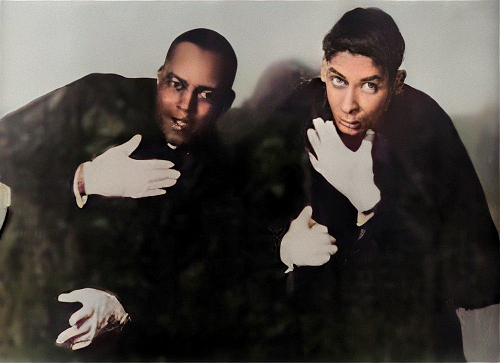 |
In 1919 Morton was on the move again, literally, as there were reports he had sunk some of his earnings into a large twelve-cylinder touring car, making most likely either a National or a Packard. After a stint in San Francisco for the winter and spring, he traveled up to Vancouver, Canada, playing for some of the summer and fall in a jazz band led by pianist and clarinetist Oscar Holden. They were likely playing in the Patricia Café in the hotel it was named after. Bricktop also joined them for a while. He allegedly also worked as a pimp during this period, but that is possibly more legend than fact. The band continued into 1920 and 1921, but Morton was restless and moved on near the end of 1919, back to the United States, into what would be a much different environment than he had enjoyed over the last decade and more.
The culprit was the vile (to many) Volstead Act, which was the enforcement vehicle for National prohibition of alcohol. New Orleans had already been dealt a blow in 1917 when the United States Navy, in an effort to keep their sailors safe and less distracted when in port, shut down Sidney Story's famed district, thereby partially ridding the city of a fairly good tax base supported by the lucrative business of prostitution. Now, the government, or more rightfully, a majority of the citizenry, decided to do away with the manufacture and sale of alcohol (albeit not the consumption, a major loophole), which was one of the drawing points of music establishment, in addition to the music itself. While all may have seemed lost at that point, the Volstead Act made alcohol more popular than ever, and the excitement of doing something not quite legal with a group of like-minded people to the wild sounds of a driving band or a blues group was just too irresistible to resist. So it was that Morton started playing in the Pacific Northwest in 1920 in Seattle and Portland in cabarets that more often than not added some coffee or tea in with their scotch. It could have been a moral disaster (depending on one's view of morality), but the alcohol and music business was soon booming again, and performers like Morton provided some of the "jazz age" soundtrack that went along with the grand experiment.
Ferd appears to have stayed up in the Northwest through at least the summer of 1920, one of his stops being the Entertainer's Café in Seattle, and perhaps back to the Patricia now and then. Down in Los Angeles, from which a somewhat weekly report emerged in the Chicago Defender by way of "letters" from musician "Ragtime" Billy Tucker, the Spikes Brothers were running their So Different Music House on Central Avenue, where the core of black life was located in that city. The sold sheet music, instruments and phonographs, and even did a bit of publishing of their own works. Among those released in early 1920 was Some Day Sweetheart, which would become associated with Morton within the next few years.
The status of Cadillac is unclear, but it appears to have closed its doors shortly after the onset of prohibition. The big venues now in Los Angeles were the Dreamland, a popular name for band venues around the country in the 1920s, and the similarly-named Paradise Gardens dance hall, another growing hot spot. Morton would make his way down there soon enough. But he was also being lured by another intriguing spot south of the border.
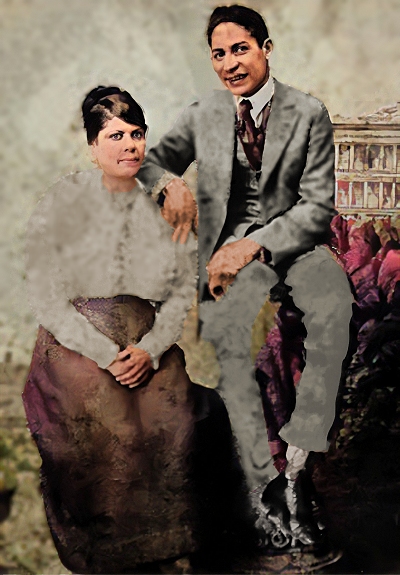 |
After bouncing around the west coast for most of 1920 and early 1921, Morton resituated himself with Anita back in Los Angeles in the late spring of 1921, and engaged his orchestra into the Paradise Gardens. They spent the summer there drawing big crowds, which according to one advertisement included some of the increasingly popular crop of "movie stars" from the Hollywood studios. For part of the summer, Jelly Roll's "Famous Creole Band" shared the venue with the Black and Tan Orchestra. The Spikes Brothers had expanded their empire as well, opening up a leisure park with amusements for "members of the Race" at Leake's Lake near the Watts neighborhood just south of downtown, calling it Wayside Amusement Park. It had become a true melting pot of African-Americans, Japanese, Asians, Mexicans, Irish, and many others, so a popular spot for boating, recreation and ja. Then in the fall came the alluring call from down south.
Tijuana (a.k.a. Tia Juana), across the U.S./Mexico border from San Diego, was enjoying new-found popularity, in part because they didn't suffer from the restrictions of the Volstead act, and actually from a number of other allegedly repressive morality laws. There was a cry for entertainers to work down there for good money in cheap living situations. Musician Eddie Rucker made his case, and in the fall a few musicians followed. Morton applied for and received one-year visas from both California and the Mexican consulate allowing him to work in Tijuana as a musician. Whether Anita went with him or remained in Los Angeles running her establishment is unclear, but she likely made a few trips at the very least. It was also a popular spot with Hollywood royalty, and many went down to see bullfights, gamble in the casinos, or simply drown their sorrows while escaping the rigors of fandom.
There is one story that soon after he started his tenure in Mexico that Morton and his orchestra were engaged to play at the prestigious U.S. Grant Hotel, named after the Civil War general and U.S. President, situated in San Diego. The gig in November, 1921, was purportedly arranged by Dink Johnson, but did not last long, albeit for unclear reasons. Johnson stated that the group was fired by management because Morton crossed his legs at the piano. The more likely story, as told by Morton, was that there was a white band playing elsewhere in the hotel and he discovered they were getting twice what his group was, so he pulled his group out and headed back across the border. Throughout the next several months Morton and his group would divide their time between Tijuana and Los Angeles, sharing the stages with a growing number of Negro jazz bands rivaling the level talent currently heard in Chicago and New York City.
By the early spring of 1922 it was announced that Morton and his band were signed for a tour on the Pantages Theater circuit, although it may have been a relatively short trip with just a few nights in each location. Within a month Tucker wrote that Morton was now managing the Wayside Amusement Park performance venue, and his six-piece band was playing there four nights a week. Near the end of April Morton's venue received a visit from no less than Chicago's current jazz champion, Joseph "King" Oliver. He reportedly set the town on fire with his brand of trumpet playing. Ferd and his band held their own reign over Wayside through the summer months, although give that it was considered a respectable establishment and a largely outdoor venue, it is unclear if alcoholic beverages were offered on a regular basis. In July, Morton's friend "Kid" Ory brought his band to Los Angeles where they made some recordings at the Spike Brother's studio, and played on the radio, reportedly the first black jazz band to do so in Southern California. They stayed there into the fall. In September, Morton took his band on a short Southern California tour outside of Los Angeles, some of it in San Diego and back to Tijuana. Then the tenure in Tijuana became tenuous.
Morton, according his interviews with Lomax, had already experienced an unfortunate incident with the law when he was briefly suspected in the slaying of a grocery store clerk in early January of 1923. In the end, arrests were made of two other black men, but it may have shaken him just enough to where he retreated back to Tijuana for a while. Then, in an unfortunate incident in early February, an American black man named Chester Carleton who was staying in Tijuana lent his car to a friend to take it to San Diego for the day. The car was in a collision with some $250 damage assessed. Carleton argued with the man, George Monteverde, and gunplay was initially diffused by a San Diego sheriff. However, they finally had a showdown just across the border on a bridge over the Tijuana River when Carleton fatally shot Monteverde, inciting a good-sized riot in the streets, and false reports of his lynching. Even though Carleton was assured he would have a fair trial, there was clear dissension against the black population, and many of them, including Morton, high-tailed it back to the North, either to San Diego or Los Angeles, not to return all that very soon.
Many of the musicians, including Ferd, sought to stage a benefit concert and dance in mid-March to raise money to buy Carleton's freedom. In spite of their best efforts to get the necessary $15,000 bond, they managed only $283.50 for that evening. This was Morton's last hurrah in Los Angeles for nearly two decades, as he would soon leave Southern California, Mexico, and his long-time love and common-law wife Anita behind, heading to where the current nexus of jazz was having a decidedly national impact - Chicago, Illinois.
Chicago, The Red Hot Peppers, and "Jelly Roll" Style
In April of 1923 Ferd found himself back in Chicago with a well-rounded résumé. It is unclear how many members of his prior orchestras and bands joined him there, but even if it was none, Morton's reputation both as a performer and composer (and a number of other disciplines) was enough to attract new talent to his side. Although only a couple of his compositions were actually in print, they had been heard by many, and would soon find their way into circulation. One of Morton's concerns was allegedly that if his style was too closely emulated in print that others might catch on to it and give him unwanted competition. But there was also the demand, and the promise of income that sheet music sales could bring. So it was that some of the early Chicago issues of Morton pieces were either simplified or simply made a bit more generic, providing a framework for his chord and melodic structure without revealing too many of his tricks.
In addition to publication, Ferd thought it was about time that he had his style heard in more than just local venues, and sought out a record company that would take him on.
According to a later memoir by blues composer and musician Perry Bradford, Morton asked him by way of a letter sent from Fort Wayne, Indiana, if Bradford might be able to get him some recording dates in New York. Perry had a better idea, which was to go to Richmond, Indiana, to see Harry Gennett, who would probably accommodate him.
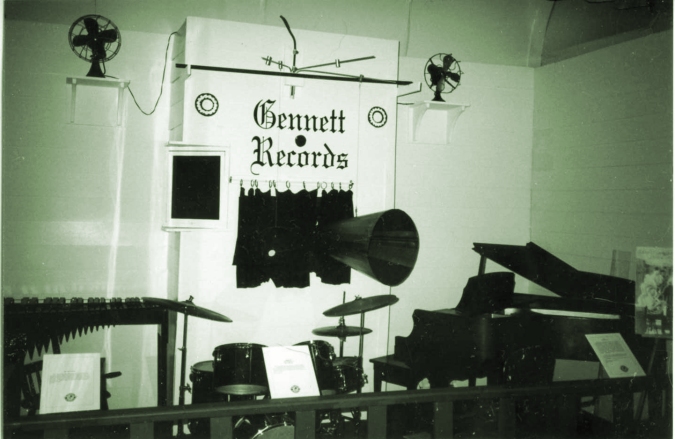 |
Gennett records was founded in 1917 by three brothers, Harry, Fred and Clarence Gennett, managers of the Starr Piano Company of Richmond, Indiana. Their initial studio was set up in New York City, but in 1921 they installed a rudimentary acoustic recording studio on the grounds of their Richmond factory. Even if the aural quality of their product was less than sufficient, the talent they attracted, being one of the first Midwest studios to record and distribute the work of black artists, was often stellar. This included the bands of King Oliver and Louis Armstrong, the New Orleans Rhythm Kings, and, in 1923, Morton.
Although he had cut two sides for Paramount Records in a Chicago studio a month prior, his first recordings of note were laid down in Richmond in July, including several with the New Orleans Rhythm Kings. Some of them included his own compositions and arrangements. The sound quality was perhaps less than Morton would have wanted, but at least now his music was available to the average consumer, both black and white, and it laid the groundwork for a more lucrative future in records, especially after the advent of electrically-recorded sound. This session was followed later in the year by one at OKeh Records in Chicago.
In order to obtain legal copyright protection and provide add-on sales through sheet music, Ferd went to the Melrose Brothers publishing company in Chicago, joining their writing and arranging staff. The company was started around 1920 by Walter and Lester Melrose, both of them important white supporters of black music in Chicago.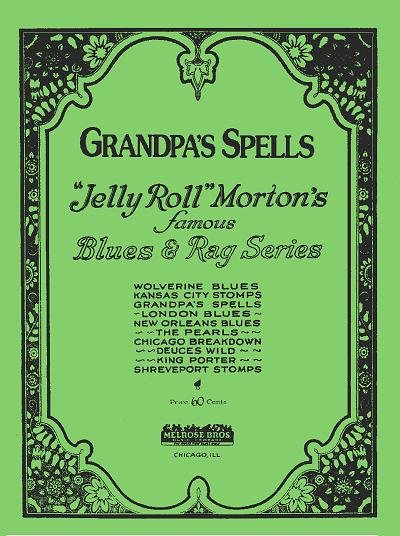 The brothers would also take on works by Joe Oliver and Louis Armstrong, calling them "staff writers" as they did with Morton. They also tended to add lyrics to tunes in an effort to collect their own royalties on the songs, but can be forgiven this for the exposure and support they gave to many black composers of jazz.
The brothers would also take on works by Joe Oliver and Louis Armstrong, calling them "staff writers" as they did with Morton. They also tended to add lyrics to tunes in an effort to collect their own royalties on the songs, but can be forgiven this for the exposure and support they gave to many black composers of jazz.
 The brothers would also take on works by Joe Oliver and Louis Armstrong, calling them "staff writers" as they did with Morton. They also tended to add lyrics to tunes in an effort to collect their own royalties on the songs, but can be forgiven this for the exposure and support they gave to many black composers of jazz.
The brothers would also take on works by Joe Oliver and Louis Armstrong, calling them "staff writers" as they did with Morton. They also tended to add lyrics to tunes in an effort to collect their own royalties on the songs, but can be forgiven this for the exposure and support they gave to many black composers of jazz.The material that the Melrose Brothers issued in 1923 and 1924 alone was comprised of some of Morton's most memorable, and over time, most played works. Morton's style was unique and emulated by many pianists, although rarely duplicated. Even in printed form it had a bounce to it, and he used many chord inversions instead of expected chord placements. His music was also more instrumental in nature, as even though he had played and recorded with many groups, he was able to imitate various instruments in his solo playing. Walter Melrose was also instrumental in making sure Morton's Gennett sessions went well, both helping to set them up as well as supporting proper rehearsal time. They routinely used the records to promote their sheet music, and vice-versa.
Grandpa's Spells, a piano rag, was one of Ferd's early favorites. He was proud of the fact that with little effort (on his part, of course) it could be played as a rag in a café, but then turned around as a lively one-step or two-step at a society party with his orchestra. Kansas City Stomps was a great demonstration of not only his bounce, but his propensity to start a trio with a slight but dramatic pause in the action. Mr. Jelly Lord made for a great salacious blues performance, while Stratford Hunch had a sense of humor embedded in its composition. The Pearls was a piece that Morton claimed was one of the most difficult jazz numbers ever written (a bodacious and suspect claim, given what has emerged since the 1940s), but with one of the more memorable trios.
There were two of these early numbers which found wide acceptance and acclaim, as well as performances on piano rolls and by bands around the United States. First was the King Porter Stomp, which was likely an homage to Porter King, whom Morton claimed was a Gulf Coast musician that he considered a dear friend and early influence. While King's identity has been challenging to historians, the piece has continued to enjoy a measure of fame in every decade since it was first published and recorded. Then there was The Wolverines, also known as the Wolverine Blues in song form.
Given the popularity of this creature as the official mascot of Michigan (embraced more so since the piece saw a measure of fame), it remains one of the most frequently played Morton pieces of that era in the guise of piano solos, duets, jazz bands, and even orchestras. Other notable works, such as Perfect Rag and the best of the Spanish-tinged pieces, The Crave, were likely composed and performed even before 1923, but did not find their way onto records or in print until the 1930s and 1940s.
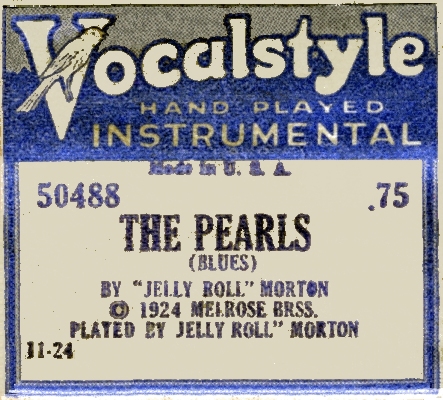 |
Of course, being that Morton was in the jazz-crazy booze-flowing flapper-happy town that "Billy Sunday could not shut down," he and his band had little trouble finding steady engagements in and around Chicago, including regional locales such from Milwaukee, Wisconsin to South Bend, Indiana. One of the hot spots in the latter town was the Tokio Gardens dance hall, about which several advertisements concerning Morton's groups appeared in late 1923 and early 1924. Other gigs followed as far off as Ohio, including one that would have some lasting impact.
Much as they had arranged for Morton's audio recordings, the Walter Melrose also hooked Morton up with the Vocalstyle piano roll company in Cincinnati, Ohio, in mid-1924. They had been supposedly the first company that put lyrics on their piano rolls, and during the peak of the player piano craze in the early 1920s (eventually killed by the phonograph, and then radio), Vocalstyle was one of the more important roll manufacturers. They were able to capture thirteen Morton performances on mark-up rolls. According to the late historian Mike Montgomery, Vocalstyle cut the rolls more or less as Morton performed them with virtually no editing, except for perhaps some missed notes. They created alternate takes in a sense to Ferd's Gennett and OKeh records, since he tended to make each performance different.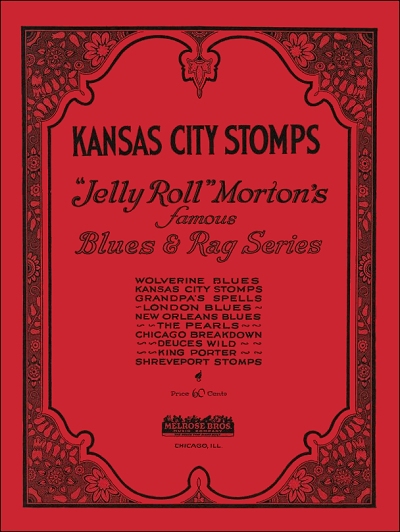 However, after the sale of Vocalstyle to Q.R.S. in 1926, followed by the decline of the piano roll business in the 1930s, many of Morton's rolls disappeared, and only recently have collectors have been able to find nine of the thirteen performances. Over the next two years Morton would cut a handful of rolls for both Capitol and Q.R.S., expanding his legacy even further with engaging performances, but would stick to recordings from 1926 forward.
However, after the sale of Vocalstyle to Q.R.S. in 1926, followed by the decline of the piano roll business in the 1930s, many of Morton's rolls disappeared, and only recently have collectors have been able to find nine of the thirteen performances. Over the next two years Morton would cut a handful of rolls for both Capitol and Q.R.S., expanding his legacy even further with engaging performances, but would stick to recordings from 1926 forward.
 However, after the sale of Vocalstyle to Q.R.S. in 1926, followed by the decline of the piano roll business in the 1930s, many of Morton's rolls disappeared, and only recently have collectors have been able to find nine of the thirteen performances. Over the next two years Morton would cut a handful of rolls for both Capitol and Q.R.S., expanding his legacy even further with engaging performances, but would stick to recordings from 1926 forward.
However, after the sale of Vocalstyle to Q.R.S. in 1926, followed by the decline of the piano roll business in the 1930s, many of Morton's rolls disappeared, and only recently have collectors have been able to find nine of the thirteen performances. Over the next two years Morton would cut a handful of rolls for both Capitol and Q.R.S., expanding his legacy even further with engaging performances, but would stick to recordings from 1926 forward.Throughout the period of 1924 into mid-1926, although based in Chicago, Morton and his band went on several tours of parts of the country, even appearing on radio from time to time in a variety of studios. They cut more sides for Gennett, and also for two other recording studios, the resulting discs which were distributed by several labels. The Walter Melrose was more or less faithful in his support of Morton's music, but as per some historians dropped the ball in one regard. Morton could have and should have become a member of ASCAP. However, it was less of a race issue and more of an administrative one that he missed that opportunity, as Melrose was not a member at that time, and he required two ASCAP sponsors and five pieces published by an ASCAP house in order to qualify. This lack of protection would haunt him near the end of his life, but for the time being he was spending his gains on fancy clothes, cars, and diamonds, the latter which he famously had embedded into one of his front teeth. Among his biggest numbers released during this period was Milenberg Joys, composed with two associates of Morton. In the spring of 1926 Morton some solo sides for Vocalion Records, many that rivaled his 1924 solos for Gennett, but recorded with much better quality.
In spite of his continuing success, one other big break that had evaded Morton was a major record label to better record and distribute his works. That was finally resolved in part by Walter Melrose, when with his assistance in mid-1926, Morton was signed to the Victor Talking Machine Company for a four-year contract. Arguably the best of the Morton records of the 1920s were those cut with his own band, the famous Red Hot Peppers. The first set of sides from the fall of 1926 were recorded using the Western Electric Orthophonic system, one of the best of that period. They were cut in the ballroom of the Webster Hotel in Chicago, a popular spot both for recording and radio broadcasts. The Morton tracks on Victor have since become legendary, and even as they were originally released quickly became best sellers for the important Victor catalog. Many of the tracks were re-recordings of tunes he had done with Gennett, Okeh, Vocalion and other labels. However, given his propensity for playing something a bit differently every time, and that Victor was recording his work with microphones instead of acoustic horns, it was worth reprising all of these works. Extant multiple takes of some of the tracks reveal differences not only in Morton's performances but also those of his band.
They were cut in the ballroom of the Webster Hotel in Chicago, a popular spot both for recording and radio broadcasts. The Morton tracks on Victor have since become legendary, and even as they were originally released quickly became best sellers for the important Victor catalog. Many of the tracks were re-recordings of tunes he had done with Gennett, Okeh, Vocalion and other labels. However, given his propensity for playing something a bit differently every time, and that Victor was recording his work with microphones instead of acoustic horns, it was worth reprising all of these works. Extant multiple takes of some of the tracks reveal differences not only in Morton's performances but also those of his band.
 They were cut in the ballroom of the Webster Hotel in Chicago, a popular spot both for recording and radio broadcasts. The Morton tracks on Victor have since become legendary, and even as they were originally released quickly became best sellers for the important Victor catalog. Many of the tracks were re-recordings of tunes he had done with Gennett, Okeh, Vocalion and other labels. However, given his propensity for playing something a bit differently every time, and that Victor was recording his work with microphones instead of acoustic horns, it was worth reprising all of these works. Extant multiple takes of some of the tracks reveal differences not only in Morton's performances but also those of his band.
They were cut in the ballroom of the Webster Hotel in Chicago, a popular spot both for recording and radio broadcasts. The Morton tracks on Victor have since become legendary, and even as they were originally released quickly became best sellers for the important Victor catalog. Many of the tracks were re-recordings of tunes he had done with Gennett, Okeh, Vocalion and other labels. However, given his propensity for playing something a bit differently every time, and that Victor was recording his work with microphones instead of acoustic horns, it was worth reprising all of these works. Extant multiple takes of some of the tracks reveal differences not only in Morton's performances but also those of his band.Among the most memorable of the Victor recordings done by Morton in Chicago was Black Bottom Stomp, equally as engaging as a band number as it was for solo piano. Sidewalk Blues was also unique for some off the beat percussion, and an opening and closing that included some sidewalk chatter and street sound effects to boot. One of Joe Oliver's numbers was included in the mix with a substantially hot take, that being Doctor Jazz. He also covered the Spikes Brother's song Someday Sweetheart, a recording for which he would be known for some time. Even though he was sharing the spotlight with Oliver, Armstrong, and other black performers of the period, Ferd and his group held their own during the peak of the jazz age. They also found a lot of traction in England on Victor's sister label, H.M.V. (His Master's Voice), garnering good reviews in the United Kingdom and Europe. The next set of records made in June of 1927 fared equally well, with some of the standouts being Wild Man Blues and the increasingly popular Wolverine Blues.
It is curious that given his contract with Melrose to write and arrange, as they copyrighted his pieces and published many of them during his five year contract from 1923-1928, that he rarely got arrangement credits on anything, particularly on his own pieces. There has been discussion about whether some of the charts were made before or after they were recorded, as some of them appear to closely emulate what made it to disc. The general consensus seems to be that Morton was a competent arranger overall, and that many times the recordings were done directly from his charts with little variance in the instrument performance other than the piano.
However, it may have been a business decision by Walter Melrose in terms of distribution of funds that kept Morton's name from having more prominence outside of composer credits.
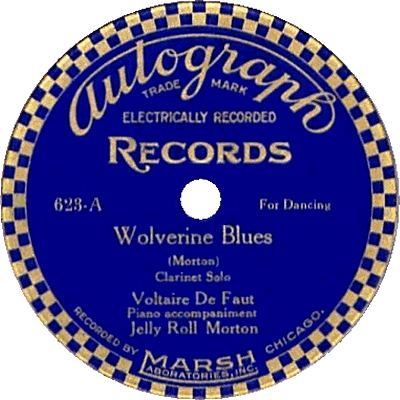 |
Morton did play with a few other musicians on Chicago recording dates from 1926 to 1928, including a few for Columbia with Johnny Dunn. However, he was usually better as a leader rather than a side man, and his best work was with his own groups. They included subsets of his band as well as the full group with the occasional shift in personnel. As the group rose in their popularity, which was publicly with black audiences and to some extent privately with white audiences who would buy the records but not always frequent the events, The Red Hot Peppers continued to tour the eastern half of the country from Buffalo, New York and Ontario, Canada, back to Milwaukee, Wisconsin. In the latter location they famously took over the Alhambra Theater during the late summer of 1927 before extending their reach into the state of Iowa. While Melrose had been responsible for Morton's music rights to that time, Morton had engaged representation in New York City, possibly through Victor, and for a while was managed by the Music Corporation of America (M.C.A.). His five-year contract with Melrose ran out in the spring of 1928, and future pieces were rarely copyrighted through the rest of his life, and even fewer would find their way into print until the 1940s.
Many of Morton's peers were enjoying an equal measure of success in 1927 and 1928, including Joe Oliver, Louis Armstrong, Fletcher Henderson, and Duke Ellington, the latter who would soon reign over the music scene of Harlem in New York City. In the late 1920s, in fact, there was a geographic shift as the center of gravity of hot jazz moved from Chicago to New York. The latter was building better clubs and theaters, had a wider reach with radio in the early days of networks, and some of the better recording studios and engineers. In the spring of 1928 Morton took his group to New York City for performances at Danceland and other venues, and in June recorded six sides at the Victor studios, likely his first sides done in New York with his band. However, his stop there was only temporary, as the band continued on a scheduled tour throughout the rest of the year, focusing more on the East and Mid-Atlantic states rather than the Northeast and Midwest.
The part of Morton's life that had been missing, or at least largely neglected since he left Los Angeles, was Anita, although there was no indication they were ever legally married. She had more or less been abandoned when he left for Chicago. There was likely a string of other women in his life for the next several years.
However, in 1927, Ferd met showgirl Mary Mabel Bertrand. A New Orleans native who was just a couple of years older than Ferd, Mabel was already married when Ferd met her, probably for the second time, and had been playing and singing in a number of stage plays, musicals and nightclubs in Chicago, New York, and the east during the mid-to-late 1920s. According to collected information, which is sketchy in some cases, Mabel and Ferd became involved in either Chicago or Kansas City, Missouri, when they started to cohabitate. Mabel claimed that she and Morton were married by a justice of the peace in Gary, Indiana, in November of 1928, although documentation of such a union has been evasive, and therefore questionable. Just the same, Mabel used the name Morton for many years, including on her Social Security Card application in 1943. From 1928 for at least part of the next decade, Mabel was Morton's companion as they traveled the country.
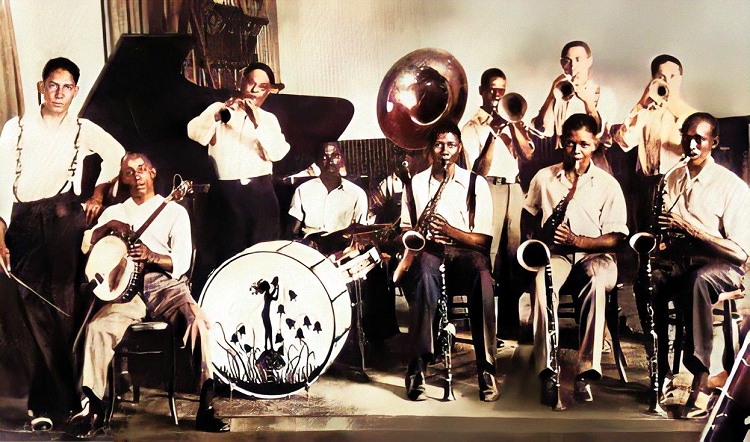 |
Much of the winter and spring of 1929 was spent in New York State and Pennsylvania playing for dancing throngs. After a Fourth of July appearance in Pittsburgh, Morton and his band traversed eastward across the state to Philadelphia. On July 8th, 1929, he crossed the Delaware into Camden, New Jersey, where Morton made a series of solo records for what was now R.C.A. Victor, the record company having recently been bought by the Radio Corporation of America. Two more sessions would follow with his group, which on the label was cited as Jelly Roll Morton and His Orchestra rather than their better known name of Red Hot Peppers. Then it was back on the road for more concertizing through much of the East, primarily Pennsylvania where the group had become extremely popular. However, changes were coming, not just for Morton and jazz, but for the entire country. The bubble of Wall Street and American prosperity on leveraged dollars was about to burst, and the timing was not so good for many musicians who had been riding high for most of the 1920s.
New York City - Depressing Times
Moving on, as always, to bigger and better horizons, and following the lead of many Chicago musicians who had found more fame either in Europe or on the East Coast, Morton and some of his band relocated their base to New York City, just ahead of the coming Great Depression. In November and December, just after the stock market crash, Morton and various personnel recorded another set of tracks in the R.C.A. Victor studios in New York City.
Although they ostensibly continued to fulfill contract dates into 1930, Morton appeared to have been possibly looking for something that would keep him more in New York on a steady basis. According to an article in March of 1930 in the Baltimore Afro-American, Morton had set up a dance school and publishing house in mid-town Manhattan in the Roseland Building a few blocks north of Times Square. For the 1930 enumeration, Ferd and Mabel were lodging in Manhattan, New York, just a few blocks from Harlem. Ferd was listed as a theater musician and Mabel as a theater actor, although having trimmed some fourteen years off her actual age.
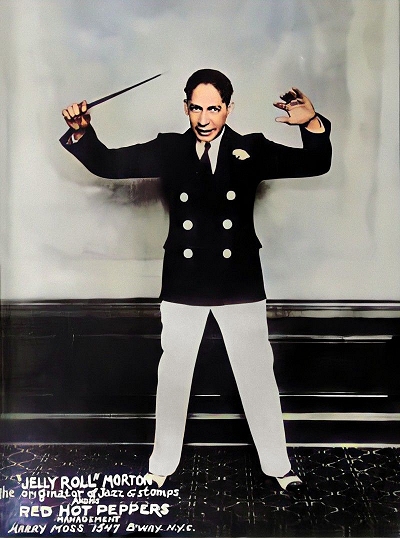 |
More recordings for R.C.A were made throughout 1930, with sessions in March, April, June and July. Ferd also worked as an accompanist for a couple of singers, and cut a few sides with his associate Wilton Crawley. One of those tracks, Fussy Mabel, was likely written for his self-declared wife. But records weren't selling so well at a time when more people were buying radios and the parts to keep them running. The growing broadcast medium had different content played on it every day, rather than the same old material, and was usually live. During a time of economic hardship radio seemed like the better investment for music fans with dwindling funds. So many piano roll and record companies went out of business, and the larger ones trimmed their belts by going more mainstream in their choices and dropping fringe or niche acts, even if they had their fans. Even sheet music took a substantial hit in the early 1930s. Such was Morton's fate after his October 9th, 1930 session after which his contract with R.C.A. Victor would not be renewed. It would be nearly a decade before he recorded for R.C.A. Victor once more.
As money dried up, so did gigs, in spite of the continuing fame of Morton's band. However, there was a flip side to this from a musically progressive point of view. Band's like those of Fletcher Henderson, Edward "Duke" Ellington and Cab Calloway, all doing well in Harlem and around the East, were moving forward into the 1930s and either adopting or setting new musical trends. Ferd had been experimental to some degree, especially with pieces like Pep and Freakish, but he was, in many regards, still embedded in his world of ragtime, blues and stomps. The recordings of his own works made this clear, even though the band did tackle some newer material by other composers. His playing style was highly unique, but did not adapt well into the age of early swing and radio crooners. Hot music also, to some, was not as appropriate a soundtrack during the Great Depression as was slower blues (which Morton did well), love ballads, and songs pulled from Broadway shows by George and Ira Gershwin, Jerome Kern, Irving Berlin and Cole Porter. To add to this, as was more readily discovered in later years, Morton was either recycling tunes under different names, or simply playing variations on his numbers, figuring to call them something different.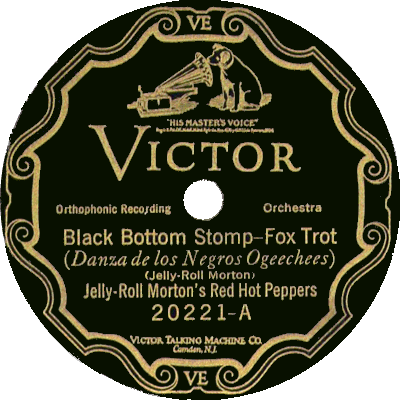 [These are noted in the Compositions list with bracketed titles.] This musical paradigm shift made Morton's remaining band, and even himself as a soloist, less viable for radio. Even the live venues were having their own troubles, some not being able to pay well, if at all time.
[These are noted in the Compositions list with bracketed titles.] This musical paradigm shift made Morton's remaining band, and even himself as a soloist, less viable for radio. Even the live venues were having their own troubles, some not being able to pay well, if at all time.
 [These are noted in the Compositions list with bracketed titles.] This musical paradigm shift made Morton's remaining band, and even himself as a soloist, less viable for radio. Even the live venues were having their own troubles, some not being able to pay well, if at all time.
[These are noted in the Compositions list with bracketed titles.] This musical paradigm shift made Morton's remaining band, and even himself as a soloist, less viable for radio. Even the live venues were having their own troubles, some not being able to pay well, if at all time.Such was the case when he presented his revue Speeding Along at the Jamaica [New York] Theater in late May and early June of 1931. The management of the theater was extracting funds from the nightly take to cover necessary costs for operation, but his spending got out of control to the point where, according to the New York Age of June 6, he was unable to pay the musicians the $00 he owed them. While the band was still able to find some work in dance venues throughout the East and New England, the payments were less. The advertising often cited Morton as appearing with his "Victor Recording Orchestra" even though they were no longer under contract to the record company. As they continued into 1932, appearing at times with other groups, Morton's name started to show up further and further down the list. Even though they had reigned during the 1910s and 1920s, the Great Depression was hard on musicians of color in the 1930s, and even their union in New York City was hard-pressed to address the problem with any great effectiveness.
By 1933 Morton was more of a fading celebrity than a working musician. His presence at occasional musical events, some honoring other musicians, was noted in the papers. However, his band was no longer extant, some of the members having sought work elsewhere, or even retreating to Chicago or their home towns. When he played out of town it was more often than not with local musicians following his charts. Claims of him playing with the Red Hot Peppers or his Victor Recording Orchestra were only partially true at times, as some of personnel were not involved with the stellar sessions of the 1920s. Performances in 1934 and 1935 were very infrequent, or at least rarely found in newspapers that have survived into the 21st century. Morton eventually distanced himself from many of his peers to the point where he was actually ostracized and outcast by the musician's union that held jurisdiction in New York. He blamed some of the musicians for not wanting to follow his charts, and imbibing at performances. However, Morton was also viewed as singularly difficult to work with, as per an article in the Philadelphia Afro-American of April 11, 1936:
THE MAN WHO REALLY INVENTED JAZZ
IS NOT PERMITTED TO PLAY IT
IS NOT PERMITTED TO PLAY IT
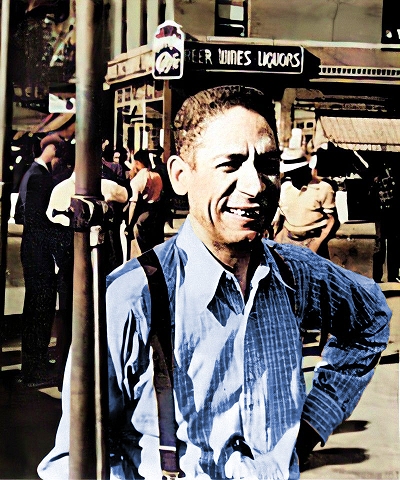 |
It is ironical, but true that the man who really invented jazz is now not permitted to play it.
Jellyroll Morton, who because of his strange piano style, created this modern rhythm, because of his disagreement with the musicians' union is kept out of organized music circles and is prevented from forming an orchestra.
Morton, who now makes his home in Harlem, claims that he was playing jazz long before James Reese Europe and his famous band made that type of music an international novelty during the war.
New Orleans is the home of jazz, according to Morton.
While Jim Europe was busying himself with the musicians' headquarters in making plans to organize a band for the 15th Regiment of the N.Y.N.G a band stole into New York from New Orleans called the Creole Band and played at the Palace Theatre for two weeks and broke all records for attendance.
Sans [sic] piano and drums, they even improved on Jim Europe's ragtime. The owner of the band was William Johnson, brother-in-law of Jellyroll Morton.
Europe went abroad with the 15th Regiment band where he introduced jazz in Europe, with the same results.
Meanwhile Jellyroll Morton set about in earnest to develop this type of music which he called jazz and discovered that it had a much better effect if played in a slower tempo.
He gave the following definition of jazz music: Jazz music is a cross between American ragtime with an inaccurate tempo and Spanish music with an accurate tempo...
With that, Mr. Morton assumes full responsibility as the creator of jazz music: Jazz music is a [sic] still in its infancy...
To further his claim that jazz is not yet perfected, Mr. Morton states that in all instruments there may be obtained, notes so odd and freakish that very few musicians are capable of producing them. Those who have, had no way of recording them because there were no such notes in the musical scale...
The article continued on with information on other famous bands playing in Harlem and New York at that time, but did not provide further details on Morton's exile from organized music, as it were. Just the same, this and continuing financial woes may have been the final straw for Morton in New York City. He had lost most of his assets, including some enterprises he had invested in, and was in disputes with Melrose Music (which was no longer owned the Melrose Brothers) over royalties and his non-admission to ASCAP. Broke and dejected, either out of pride or embarrassment, or very likely just frustration, he extracted himself from New York in May or June of 1936 and moved down to Washington, DC, where he would find himself all but forgotten in the wake of the swing era, which would officially start later that year out in California.
Washington, DC - Obscurity, Then Rediscovery
Mabel, who had remained in New York, later noted that she thought Ferd had moved to the Nation's Capital with the intention of promoting professional fights, and not so much to continue in music. However, without seemingly trying to make a splash, but merely a statement, Ferd walked in to the offices of Washington, DC, broadcast station WOL in mid-June of 1936 and asked for an audition, reportedly without even giving his name, as noted in the Washington Daily News of June 23. Needless to say he passed their audition, and once he announced who he was the lights clearly turned on for most in the place. So for a few days in late June and early July, Jelly Roll Morton gave his own accounting of the history of jazz over the airwaves in Washington. Then he all but disappeared.
Over the next several months, Ferd managed to find work and part-ownership in a downtown Washington D.C. bar at 1211 U Street in the black area of town. Under a variety of names, including The Music Box and The Blue Moon Inn, it was best remember as The Jungle Inn when it was finally "discovered" as it were. Morton went into the partnership with a woman named Cordelia Rice Lyle. The relationship likely went a bit beyond professional as well.
It has been thought that Morton's 1938 tune Sweet Substitute was written for Cordelia or with her in mind. In any case, Ferd was under the radar for some time, known only to local crowds, who came down to hear him play, present little shows, and act as a master of ceremonies for certain events, keeping The Jungle in business to a degree. He was also a bartender, barrel opener and bouncer, taking on many roles that would have seemed unlikely just a decade before.
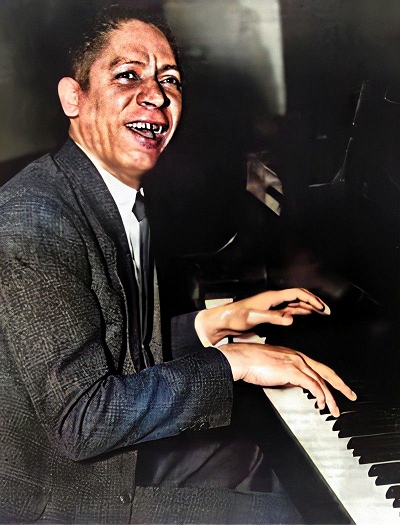 |
A small note appeared in Down Beat magazine in a May, 1937 issue, noting that "The Originator of Jazz and Swing" (in 1906 no less) was playing at The Jungle Inn. This was seen by a few fans, including another Down Beat writer, James Higgins, who followed the trail to U Street, "smack in the center of the town's jig district." Somebody else who found him at this time, likely through word of mouth, was Mabel. After some awkward apologies on Ferd's part concerning his seeming abandonment and lack of communication, she joined him for a time in Washington, which could have been a tenuous situation, but was handled in a civil matter by all parties. She made it clear that she was accepted as Morton's wife, and treated as such.
Down Beat continued to find interest in the historical aspect of the somewhat forgotten Jelly Roll Morton, and From December, 1938 to March, 1938, published a three-part article written by Professor Marshall Winslow Stearns, which outlined Morton's version of the history of jazz and swing. Having started out from the very opening with a falsehood - he gave his birth year as 1885, possibly to prove him as old enough to have invented jazz - it gave an accounting of a number of events of his earlier years; some true, some enhanced, and some later found to have never happened. To be fair, Stearns, perhaps a bit in awe of his subject, was partially complicit in the soft lies and blatant inaccuracies, having not expanded his research in many cases where it could have told another story.
The attention from Down Beat was followed by other stories, including one published in Washington, which credited him with the roar heard in Tiger Rag, taking his name from the composition which got him started (albeit in 1910), and having recorded for Victor as far back as 1905 (only 21 years off the mark). There were other fantastical tales within that March, 1938, article, including Morton ending up in jail at six months with a drunk baby-sitter, and referring to the area between New Orleans and Mobile, Alabama, as the "Cradle of Swing," which is a suspect claim at best. However, Morton nonetheless represented jazz and American music history in a colorful manner, and his popularity was clearly gaining traction again, if among those interested in nostalgia or a window to the past.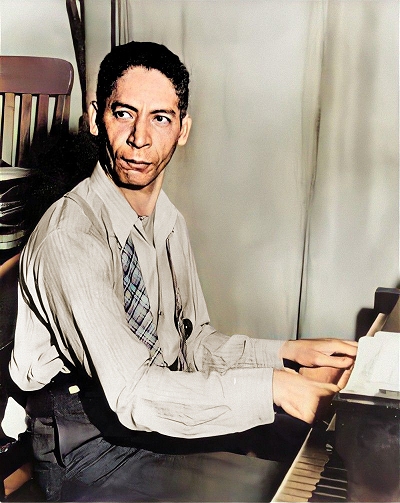 Even though he liked to talk about the past, he was also trying to promote his newer compositions and playing style, perhaps in an effort to become relevant to a new generation.
Even though he liked to talk about the past, he was also trying to promote his newer compositions and playing style, perhaps in an effort to become relevant to a new generation.
 Even though he liked to talk about the past, he was also trying to promote his newer compositions and playing style, perhaps in an effort to become relevant to a new generation.
Even though he liked to talk about the past, he was also trying to promote his newer compositions and playing style, perhaps in an effort to become relevant to a new generation.Morton so believed many of the tales he had been spinning that he actually took umbrage at a radio broadcast he heard one evening that seemed to diminish his credit in jazz history. The March 25, 1938 broadcast of the popular syndicated radio show, Ripley's Believe It or Not, did a profile on W.C. Handy and a short history of jazz and blues. In that profile Handy was referred to as the originator of jazz and blues [a claim that has sense been disproven, as both came about by committee more so than any one individual]. Morton immediately fired off a letter that was closer to a manifesto than a simple challenge to the claim. Sent not only to Ripley's, but to the Baltimore Afro-American and Down Beat magazine, the latter who he felt had treated him favorably, the letter asked for Ripley's to furnish proof of their information, as he knew better. In fact, he had invented jazz in New Orleans in 1902, several years before Saint Louis Blues had been played in 1911 [it was actually 1915]. Having allegedly met Handy in 1908, Morton noted that he did not have nearly the ability required to play such music, and actually [a somewhat correct assertion] had taken many of his themes from other musicians, forming his own works. After going on about the supposedly true history of how Saint Louis Blues really became famous, which was through his own arrangement as played by white bandleader and self-proclaimed "King of Jazz" Paul Whiteman (also a spurious claim), he went on to explain how the standard arrangement of instruments for jazz bands evolved, and closed with a lament about the need for stricter copyright laws, no doubt a reference to his ongoing battle with Melrose Music. A similar letter found its way into an edited version in the Washington Post in early May. Before long they were a point of discussion in the music business, and in spite of Morton's wishing Handy success in the music business, it could not help but chill their relationship, as well as negatively taint the opinion of some readers who knew better against Morton and his attitude.
Either because of the Down Beat articles or the Ripley's melee, Ferdinand "Jelly Roll" Morton was fortuitously "rediscovered" by historian Alan Lomax in May of 1938. Lomax was a Texas native who, like his father, John Avery Lomax, became a folk-music archivist. The Lomax ventures starting in 1933 were largely funded by the Library of Congress, and they essentially went out into the field around various parts of the country with recording equipment capturing what they felt was the most genuine or indigenous folk music from each locale. Some artists who later became well known were actually made so through the efforts of the Lomaxes, including folk singer Woody Guthrie and blues guitarist Huddie "Lead Belly" Ledbetter.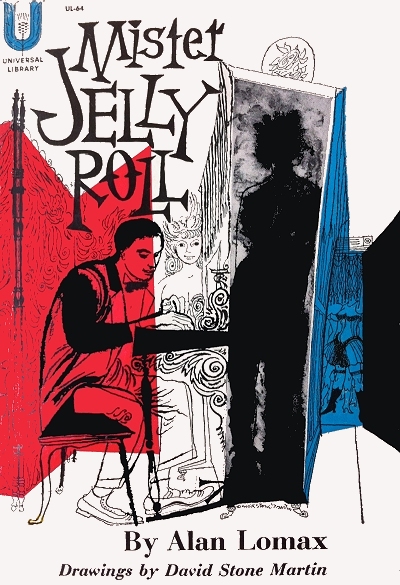 In 1937 at age 22, he became a Washington resident when the Library appointed him as an assistant archive director, essentially a custodian and historian for the work he and his father had already accomplished.
In 1937 at age 22, he became a Washington resident when the Library appointed him as an assistant archive director, essentially a custodian and historian for the work he and his father had already accomplished.
 In 1937 at age 22, he became a Washington resident when the Library appointed him as an assistant archive director, essentially a custodian and historian for the work he and his father had already accomplished.
In 1937 at age 22, he became a Washington resident when the Library appointed him as an assistant archive director, essentially a custodian and historian for the work he and his father had already accomplished.It was Jelly Roll enthusiast and record collector Sidney Martin who actually introduced Morton to Lomax. This presented a unique opportunity for Lomax, because unlike many of his subjects, Ferd had already been well-recorded, even if his efforts were becoming distant memories. In this instance, it allowed Alan to focus more on the history of the music, including blues, ragtime and stomps, from the slightly inflated but still informed point of view of Morton. Having obtained permission and some funding, Alan took a Presto disk recorder (it seems likely that there were two in order to overlap the end of one disc with the start of another) to the Elizabeth Sprague Coolidge auditorium, and between May 23 and December 14, 1938, recorded around nine hours of conversations with and music played by Morton. Some was biographical and some was historical in context, but in spite of some inaccuracies or selective memory moments on the part of Morton, it remains one of the first and best oral histories of the ragtime era and the days of early jazz.
The resulting recordings eventually begat three separate threads, two of which, when they first appeared, were groundbreaking, even if time has managed to add a number of annotations or corrections to each. The first was Lomax's book Mister Jelly Roll: The Fortunes of Jelly Roll Morton, which appeared in 1950 some nine years after Morton's death, and incidentally around the same time as another pioneering book that touched on Morton here and there, They All Played Ragtime by Rudi Blesh and Harriet Janis. Alan, who was still in his mid-thirties when his tome was published, did the best he could with the information he had gotten a decade prior. There was some research outside of the sessions with Morton applied to the text, but much of it was riddled with inaccuracies, misalignments, or plain old misinformation, some of it coming from Morton, and some of it through the difficult process of listening to the discs which sometimes had noises or other errors. The latter problem was particularly prevalent when it came to how he interpreted the pronunciation and spelling of many of the names Morton ran off during his narrative. There have been some improved texts since that time, but one of the best sources to consider outside of Lomax's book is the research compiled at the site of the late Mike Meddings of England (see credits below for more),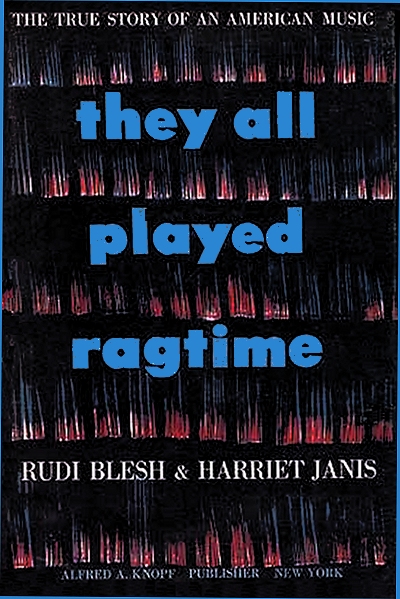 which although it is not as much a narrative like a book, could be considered a detailed annotation of Morton's life with a number of interesting sidebars. Without Lomax's accumulative efforts, the information we have now on Morton would be lacking to quite a degree.
which although it is not as much a narrative like a book, could be considered a detailed annotation of Morton's life with a number of interesting sidebars. Without Lomax's accumulative efforts, the information we have now on Morton would be lacking to quite a degree.
 which although it is not as much a narrative like a book, could be considered a detailed annotation of Morton's life with a number of interesting sidebars. Without Lomax's accumulative efforts, the information we have now on Morton would be lacking to quite a degree.
which although it is not as much a narrative like a book, could be considered a detailed annotation of Morton's life with a number of interesting sidebars. Without Lomax's accumulative efforts, the information we have now on Morton would be lacking to quite a degree.The second thread involved the recorded material itself. There were many faults in the recordings, the most prevalent one being a lack of consistent speed. The Presto machine(s) had been adapted to work on batteries, but it would seem likely that AC power would have been used for the sessions, unless the reconfiguration of the device removed that capability. They also reportedly ran anywhere from 80 to 87 RPM, 85 being the best average speed to reproduce the content at the proper pitch. Still, the speed was not consistent between discs, and not even from the start to finish of a single disc. Even though they resided at Library of Congress, (and possibly a copy that ended up with Morton, and then his estate), permission was needed to release any of the material for the public. After several attempts by collectors and enthusiasts to gain access to them through his estate lawyer, a representative was sent by Circle Records, which was run by Rudi Blesh, to secure the permission to run off a limited edition. The plea worked, and Blesh spent time at the Library of Congress trying to get an acceptable transfer from their staff. The job was apparently rushed, and little or no effort was made to fix sound issues, and particularly speed issues, perhaps in order to move Blesh on his way.
Editing had to have been an issue, even when dealing with hard-core enthusiasts, because some of Morton's material was, itself, hard-core in its profanity and graphic content. With some effort, however, perhaps just over 300 sets of the dubs were released to the public through mail order in the late summer of 1947, which was in the form of 45 Vinylite 12" discs. It is notable that the following year would see the introduction of both the long-playing record and commercial audio tape recording, both of which would have been of great benefit to this particular project. Blesh did attempt to rectify some of the issues by presenting a release in 1950 consisting of 12 LPs, but all of the noise and speed faults remained, making it even a poorer seller than the first edition.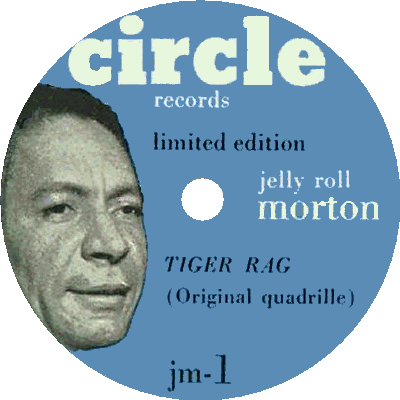 Over the years, technology has been re-applied to the originals to fix noise and speed faults, resulting in a limited-scope 4 CD set release partially funded by Congress in 1994. Eventually the entire set of recordings, cleaned up, speed corrected, and with all of the original profanity and pornography intact, was released in 2005.
Over the years, technology has been re-applied to the originals to fix noise and speed faults, resulting in a limited-scope 4 CD set release partially funded by Congress in 1994. Eventually the entire set of recordings, cleaned up, speed corrected, and with all of the original profanity and pornography intact, was released in 2005.
 Over the years, technology has been re-applied to the originals to fix noise and speed faults, resulting in a limited-scope 4 CD set release partially funded by Congress in 1994. Eventually the entire set of recordings, cleaned up, speed corrected, and with all of the original profanity and pornography intact, was released in 2005.
Over the years, technology has been re-applied to the originals to fix noise and speed faults, resulting in a limited-scope 4 CD set release partially funded by Congress in 1994. Eventually the entire set of recordings, cleaned up, speed corrected, and with all of the original profanity and pornography intact, was released in 2005.The third thread was the part that reignited the subject himself, Jelly Roll was so encouraged by this growing interest in his history and his music, particularly from Down Beat fans, that even before the initial sessions with Lomax he assembled a small ensemble and drove up to a studio in East Baltimore, Maryland, to record a series of tracks. Most of them were pieces by his contemporaries, including the iconic Honeysuckle Rose by Thomas "Fats" Waller. One other session would follow in August, resulting in three of his own compositions committed to disc. They were not commercially released until decades after his death, so the intent of these sessions is unclear, but evidently one that represented the hope of the comeback for Ferd.
Another set of articles appeared in Down Beat during the late summer and fall of 1938, both culled from and in response to the Ripley letter. One of those was a letter from W.C. Handy, who made it clear that he was a blues player, not a jazz player and that "I would not play jazz, even if I could." He redressed both Morton and Down Beat, the former being accused of attacking him like a "crazy man," and the latter for their choice of running the original letter with the headline "W.C. Handy is a Liar." It was backed up with a great deal of credible information to support Handy's original claim, and, at least for the time being, appears to have put everybody in their proper place historically at the very least, even though Handy was adamant about his [questionably] having created the Blues music form. Just the same, the reaction of some papers was to fan the flames a bit, and the debate on who was right, perhaps neither of them, continued in Down Beat well into the following year.
Throughout 1938, Ferd had continued to work at the Jungle Inn, which was the Blue Moon by this time, with Mabel joining him behind the bar and as a waitress. According her account as found in Lomax's book, it was one evening in August that Morton had to exercise his role as a bouncer when a patron became a bit too rowdy and used some foul language. Ferd allegedly slapped the man to put him in line, and then went back to the piano to fulfill his role as entertainer. The culprit then sneaked up behind Ferd at the piano and stabbed him somewhere in the head or neck. When Morton turned around to deflect the man, the knife entered his chest just above heart. Mabel ended the conflict with a well-placed ashtray on the man's head, preventing any further injury. The customers also had to pull Ferd off the man as he was ready to lay into him with a pipe. Just the same, the chest wound that he suffered was potentially mortal in nature.
Rushed to a local Washington hospital by the police, Morton was quickly put under an electric fan to combat the August heat, but also given an ice water pack on his wounds.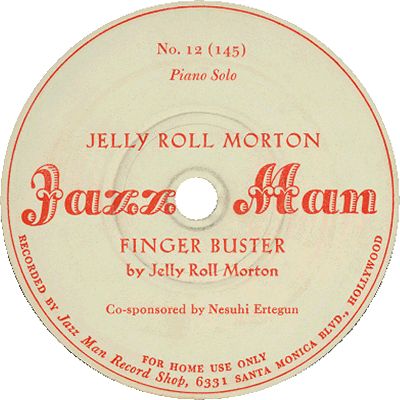 The end result was that it stopped the flow of blood through the wound, but not inside the body. The resulting pool of blood that may have remained above his heart for some time, coupled with what may have been three-decade bout of syphilis, ultimately contributed to a decrease in pulmonary function for Morton. Had the wound been properly tended to on the spot, or the venereal disease treated with penicillin (not yet available during his lifetime), Jelly Roll might have had a fight chance. However, his descent into a death that would come within three years likely began that August night.
The end result was that it stopped the flow of blood through the wound, but not inside the body. The resulting pool of blood that may have remained above his heart for some time, coupled with what may have been three-decade bout of syphilis, ultimately contributed to a decrease in pulmonary function for Morton. Had the wound been properly tended to on the spot, or the venereal disease treated with penicillin (not yet available during his lifetime), Jelly Roll might have had a fight chance. However, his descent into a death that would come within three years likely began that August night.
 The end result was that it stopped the flow of blood through the wound, but not inside the body. The resulting pool of blood that may have remained above his heart for some time, coupled with what may have been three-decade bout of syphilis, ultimately contributed to a decrease in pulmonary function for Morton. Had the wound been properly tended to on the spot, or the venereal disease treated with penicillin (not yet available during his lifetime), Jelly Roll might have had a fight chance. However, his descent into a death that would come within three years likely began that August night.
The end result was that it stopped the flow of blood through the wound, but not inside the body. The resulting pool of blood that may have remained above his heart for some time, coupled with what may have been three-decade bout of syphilis, ultimately contributed to a decrease in pulmonary function for Morton. Had the wound been properly tended to on the spot, or the venereal disease treated with penicillin (not yet available during his lifetime), Jelly Roll might have had a fight chance. However, his descent into a death that would come within three years likely began that August night.Due to a sketchy recovery, Mabel was reticent for Ferd to return to any type of work schedule, which included the physically exerting activity of playing the piano. She would have none of it, but Ferd would have none of the alternative, and was soon playing again, albeit with more effort expended. His time in Washington was coming to a close, and he felt like the opportunity for a comeback was a reality due to the continuing Down Beat mentions, fan letters, and even the controversy. The final recording session between Morton and Lomax in December was followed by one in the WINX studio in Washington where he recorded a few sides that were soon released on Jazz Man records, based in Hollywood, California. This further encouraged him, and the decision was made. No more bartending. No more brawls. He needed to get back to a life of publicly acknowledged performance, and there was one place for that. So (according to Mabel) on Christmas Eve of 1938, Jelly Roll and the Mrs. pointed their car northward, and drove through a blinding snowstorm back to New York City, allegedly never looking back.
New York and Los Angeles - The Final Years - A Hard Road Traveled
Ferd's intent was clear, and by late December, even before leaving DC, he had sent a letter off to Down Beat listing members of his new All-Star Band. In fact, most announced in a letter published in Down Beat in February of 1939 were indeed well-known, even if it was more of a wish list, since not all of them stayed with Morton for very long. As for his New York status, letters published in Down Beat in February and March were shown as originating from Washington, DC, which either was a latency issue with publication, or perhaps Morton's December break was not all that definitive. In any case, he was playing gigs in Harlem by the late spring, and one at the Golden Gate Ballroom nearly did him in, even before he made the stage. Lomax, who visited him in New York, and some others, made it clear that Morton was far from healthy. The accumulative blood pool had lowered pulmonary and lung function to a point where Morton was experiencing asthma and overall breathing difficulty.
So his opening night at the Golden Gate turned into a trip to the hospital, where he remained for several weeks, according to Lomax. When he was released, it was reportedly with the advice that he should discontinue his work as a professional musician. This sage warning apparently just bounced off of Morton, who went right back into the fray.
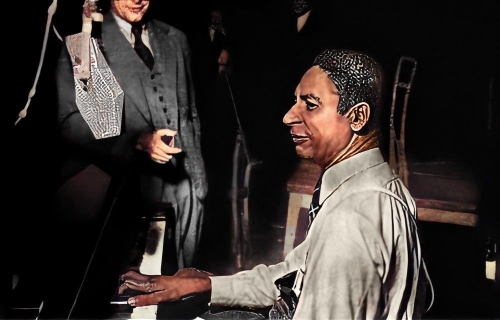 |
After a nine year hiatus, he went into the R.C.A. Victor studios with his band to cut some discs for their side label, Bluebird Records. Although Morton had new material to offer, he and the band, now called the New Orleans Jazzmen, recorded some old New Orleans favorites, some of which he had recently relayed to Lomax at the Library of Congress. These two September dates were his final sessions Victor records. The inclusion of musical veterans such as soprano saxophonist Sidney Bechet and trumpeter Sidney de Paris, as well as drummer Zutty Singleton, were all noteworthy, although a report in Down Beat indicated that Morton was not entirely pleased with the results or his choice of personnel. There were follow-up sessions in December held at Reeves Sound Studios in Manhattan, comprised largely of older works played as solos by Morton. These sessions continued into January, 1940, and were capped by two dates with other musicians near the end of the month. Even though it was not his intention, these were has last official appearances in a recording studio. During that period, Ferd had also done a couple of radio appearances, but regular playing dates in public appeared to have been avoided by necessity, with only occasional appearances at special events where he shared the stage with some of his notable peers.
When the Bluebird album was released in late February of 1940, the event was picked up by Time Magazine, which did a short article in their March 11 issue, mostly a short biography. The Bluebird set was closely followed by the release of his Reeves tracks on the General Records label, the latter not well marketed, and therefore met with limited public interest and tepid sales. As he had been doing for the past couple of years for interviews, Ferd insisted that his year of birth was 1885, making it easier for historians and the public to believe he was actually present at the birth of jazz, perhaps delivering it as well.
The 1940 enumeration, taken on April 17, showed Ferd and Mabel residing in a Harlem boarding house, and he was listed as a "music composer," rather than as a musician, working from home. For this record he softened up on age just a little, indicating a probable 1886 birth year.
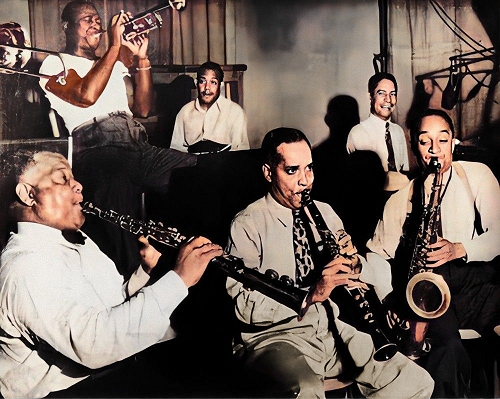 |
During his time in New York, Morton was fighting two other battles, one which he eventually won, and another that turned into a frustrating mission of futility. Due to the Walter Melrose's non-affiliation with ASCAP during his tenure with Morton, Ferd was not qualified to be inducted into that organization, which was proving to be a relatively good service for protecting the legal rights of musicians and collecting royalties for them. The latter had also been an issue, and Morton felt he was owed considerably more for both the recordings and publications of his works from the 1920s than he had received. This put him into a fight with Melrose Music (which had not been run by either Melrose brother for many years) and MCA, who had hosted his tours of the late 1920s. While Ferd was pursuing some form of recompense for his work, he was admitted into ASCAP, although whether it was through a softening of the rules, other affiliations (two member sponsors were necessary as well), or simply in recognition of his contributions to music is unclear. Either way, he was an ASCAP member before 1939 was out. The royalty fight continued in the press nearly to his death. He told Down Beat in their October 1, 1940, issue, that he estimated he had been "robbed of three million dollars" in royalty payments because, "Everyone today is playing my stuff and I don't even get credit." Given the time that had elapsed since the original alleged inactions, and the changeover of ownership of Melrose Music, the end result was not favorable to Morton. Having filed an action as early as 1939, which was escalated in the spring of 1940, he ended up having to drop it by August, likely due to diminishing resources and health concerns.
With his breathing issues limiting his appearances, Morton did whatever he could to stay relevant, either with the occasional radio appearance or contributions to jazz history through interviews. However, he did have big plans in his continuing efforts at a comeback. In November of 1940 he headed west, without Mabel, and back to the place where he first rose to fame, hoping he might do so again. Ferd Morton relocated back to Los Angeles, California.
The trip was an arduous one, and ill-advised, given his diminishing health. Morton drove through the northern tier of the Midwest in his Lincoln while towing his 1938 Cadillac sedan on a chain. The Lincoln was not in good shape, and he had to abandon it in Idaho in a snowstorm, continuing on to California in the Cadillac. Along the way he wanted to make an old connection, stopping in Canyonville, Oregon, to visit with Anita. She had been married to a white service station and restaurant owner named Jack Ford in the mid-1920s (providing more evidence that she and Morton had never made their union official), but still cared for the aging and now increasingly challenged Ferd. This was not the last they would see of each other.
Finally arriving in Los Angeles in mid-November, Ferd he teamed up once again with Benjamin Spikes, forming a new publishing company in Hollywood to issue his works and establish copyrights.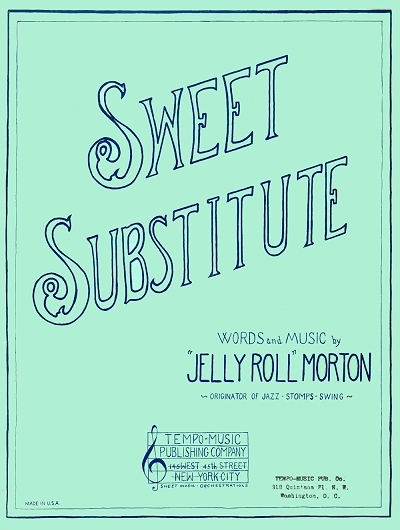 In spite of his hard-fought affiliation with ASCAP, Morton and Spikes chose to align their company with the recently formed rival protective agency, BMI. In doing so, Ferd also made assurances to that entity that he could secure them a cadre of talented Negro composers, increasing BMI's overall worth in a time when many of those composers were making major contributions to white swing bands, most notably the various groups of clarinetist Benny Goodman. However, armed with charts of fresh arrangements, he hoped to perform and record new material as well, some with his old friends who had stayed in Los Angeles, including Edward "Kid" Ory, Ed Garland, Bud Scott, Ram Hall and Mutt Carey.
In spite of his hard-fought affiliation with ASCAP, Morton and Spikes chose to align their company with the recently formed rival protective agency, BMI. In doing so, Ferd also made assurances to that entity that he could secure them a cadre of talented Negro composers, increasing BMI's overall worth in a time when many of those composers were making major contributions to white swing bands, most notably the various groups of clarinetist Benny Goodman. However, armed with charts of fresh arrangements, he hoped to perform and record new material as well, some with his old friends who had stayed in Los Angeles, including Edward "Kid" Ory, Ed Garland, Bud Scott, Ram Hall and Mutt Carey.
 In spite of his hard-fought affiliation with ASCAP, Morton and Spikes chose to align their company with the recently formed rival protective agency, BMI. In doing so, Ferd also made assurances to that entity that he could secure them a cadre of talented Negro composers, increasing BMI's overall worth in a time when many of those composers were making major contributions to white swing bands, most notably the various groups of clarinetist Benny Goodman. However, armed with charts of fresh arrangements, he hoped to perform and record new material as well, some with his old friends who had stayed in Los Angeles, including Edward "Kid" Ory, Ed Garland, Bud Scott, Ram Hall and Mutt Carey.
In spite of his hard-fought affiliation with ASCAP, Morton and Spikes chose to align their company with the recently formed rival protective agency, BMI. In doing so, Ferd also made assurances to that entity that he could secure them a cadre of talented Negro composers, increasing BMI's overall worth in a time when many of those composers were making major contributions to white swing bands, most notably the various groups of clarinetist Benny Goodman. However, armed with charts of fresh arrangements, he hoped to perform and record new material as well, some with his old friends who had stayed in Los Angeles, including Edward "Kid" Ory, Ed Garland, Bud Scott, Ram Hall and Mutt Carey.Some of Morton's movements of this time period are partially known through a series of mildly passionate letters addressed to Mabel in New York. A number of them were full of promises never kept, and even more lamented his failing health and financial woes. That Anita had come down from Oregon in early 1941 to tend to Ferd's health seems to have never been a topic discussed in this correspondence. His friends and colleagues in Los Angeles were aware not only of Anita's presence, but Morton's failing health, which made the news in Down Beat in early April. It mentioned that he was "Seriously ill in a little cottage just off Central Avenue," which was likely the house of Anita's brother Dink Johnson. The article also noted that he had been suspended from the American Federation of Musicians for a $45 claim made against him by two other members some time back. After further indicating that his enterprise with Spikes had similarly failed, it made it clear that "He's angry at the AFM, angry at ASCAP, angry at BMI, angry at the old pump [heart] for letting him down when he had so much to do. He's just angry enough to fight back like all hell — and maybe win.
Less than three weeks later it was announced in the Los Angeles Times that Morton had been secured as a technical adviser for R.K.O. pictures, specifically concerning scenes with old minstrel show dances for the film The Band Played On. This was an optimistic endeavor at best, but a role he never fulfilled. It was also around the time that his letters to Mabel ceased, leaving her somewhat in the dark about his dire situation. Those who read the news stories in Down Beat and had some concern about his plight offered to help, but Morton politely turned them down, as noted in their May 1 edition, promising that he was in better condition. "I've had plenty of trouble, all right, but I'm not licked." Unfortunately that was not the case.
As his heart was working harder just to keep him mobile, Morton's strength quickly waned. In early June he was sent to a sanitarium to deal with the asthma and pulmonary issues. Down Beat reported this, albeit a few days too late, and noted that Ferd was in need of financial assistance as well. By late June, Ferd was admitted to Los Angeles County General Hospital. Anita was by his side throughout the ordeal, and had been helping defray the finances with help from her husband. While he was still questionably "of sound mind," Morton made out a will or something like it that bequeathed his assets and the copyrights he owned to her. It would later become a controversial point of contention in a number of legal battles.
Ferdinand Joseph Lamothe "Jelly Roll" Morton died on July 10th, 1941, at age 50, reportedly with Anita at his bedside. She was the official informant on his death certificate, claiming to be Mrs. Morton, although there is some possibility this was a clerical decision. The official cause was "cardiac decompensation" due to "hypertensive heart disease," meaning that he literally and figuratively died of a broken heart. There were many tributes to Morton in the days and months that followed, but perhaps the least of them was his poorly attended funeral at Calvary Cemetery in East Los Angeles, noted in part in a Chicago Defender article of July 26, 1941, for who did not show up. The names that were called out for this purported lack of respect were bandleaders Edward "Duke" Ellington and Jimmy Lunceford, as well as singer Ella Fitzgerald, all of who were in Los Angeles at the time. His pall bearers included Ory, Carey, Garland, and Fred Washington, but over the years, Morton's bodacious claims and arrogant attitudes had lost him a lot of friends in the music business, even if they thought better of him years after his demise.
The Legacy of "Jelly Roll" Morton
In the years that immediately followed Ferd's death, Anita faced legal challenges as to her inheritance, such as it was, particularly by Mabel Morton who challenged both Anita and the estate.
Even before that, Anita had filed her own action against his official estate for monies owed to her. By mid-decade, Anita and Jack Ford had relocated to the Los Angeles area, eventually running a restaurant there. When an effort was made by a jazz club to erect a better monument in 1950, the organizers, led by Floyd Levin, thought to ask her permission to do so. They had a benefit concert planned in order to raise the funds. Anita, just as proud as Morton in a sense, denied them that privilege, insisting that she would put up an improved marker in short order. She came through at the same time as the concert, as she promised. However, the incident was beneficial in that her interview with Levin provided a bit more insight to Morton's final weeks in Los Angeles. Anita would die in 1952, and was buried in the same cemetery as Ferd, not too far off from him.
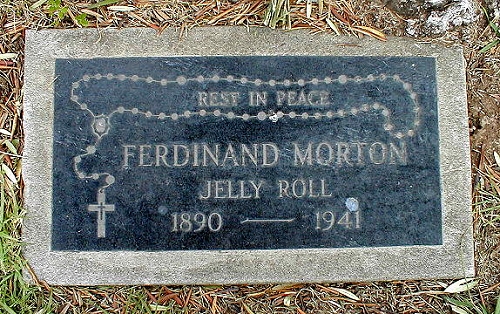 |
A lot of the material Morton left us was not released or even notated until after the Library of Congress recordings were released in the late 1940s. So in some cases it is hard to pinpoint original composition dates of certain works, even though he claimed they were from this or that year, based on the validity of his other questionable claims. There are probably many more tunes that we may never know about, but what was left behind certainly whets the appetite for traditional jazz fans to hear more. In fact, that happened not long after he died, as bandleader Lu Watters, along pianist Wally Rose, did a series of recordings in San Francisco in 1941 and 1942 as the Yerba Buena Jazz Band. While these tracks, which included ragtime favorites and pieces made famous by Morton, Armstrong and Oliver, were limited in their reach, they are considered by historians to be the first effort of what would become a massive revival of both ragtime and traditional jazz in the early 1950s.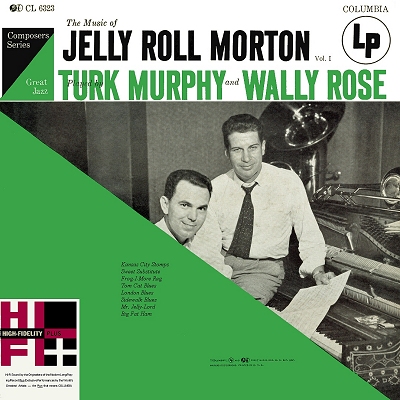 World War II interrupted this effort, but by 1947, Rose, Watters, and selected others across the country, were finding more favor with the listening public when they played the old jazz once again.
World War II interrupted this effort, but by 1947, Rose, Watters, and selected others across the country, were finding more favor with the listening public when they played the old jazz once again.
 World War II interrupted this effort, but by 1947, Rose, Watters, and selected others across the country, were finding more favor with the listening public when they played the old jazz once again.
World War II interrupted this effort, but by 1947, Rose, Watters, and selected others across the country, were finding more favor with the listening public when they played the old jazz once again.Three pianists from the San Francisco Bay area are notable in their dedication to Morton's legacy. Wally Rose was given the latitude to include ragtime solos as part of the YBJB recordings that would soon be released by Lester Koenig on his pioneering Good Time Jazz label. He would also record a full album of sixteen of Morton's works for Columbia Records with Turk Murphy's band in the mid-1950s. Another fine pianist was Burt Bales, an under-recorded and at times under-appreciated proponent of ragtime and traditional jazz. But perhaps the most legendary of the three, and the most evasive in spite of his popularity, was Paul Lingle. His vast repertoire included a lot of Morton works, as he had been influenced by hearing the master play live in the late 1910s. On his only studio album comprised of eight tracks, half of them were skillfully arranged Morton numbers full of choice subtleties that even Jelly Roll rarely included in his own recordings.
The ragtime and traditional jazz revival of the 1950s helped to raise the level of awareness of Morton, as did the two previously mentioned books, Mister Jelly Roll and no less than four editions of They All Played Ragtime issued between 1950 and 1974. A more complete look at the life of Scott Joplin in 1970 through two folios produced by Vera Brodsky Lawrence and the New York Public Library further heightened interest in ragtime as well as Morton's music, and ignited the interest of a whole new generation of young pianists, including this author. Among the experts that played his works during that decade was the incomparable Richard Hyman, who cut a couple of fine albums of Morton classics.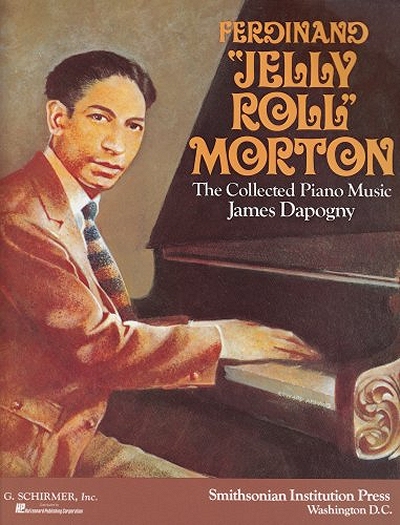 His character also made the occasional incursion into Hollywood films, either through a portrayal or at least a mention of his name, along with snippets of his famous tunes.
His character also made the occasional incursion into Hollywood films, either through a portrayal or at least a mention of his name, along with snippets of his famous tunes.
 His character also made the occasional incursion into Hollywood films, either through a portrayal or at least a mention of his name, along with snippets of his famous tunes.
His character also made the occasional incursion into Hollywood films, either through a portrayal or at least a mention of his name, along with snippets of his famous tunes.Morton's arrangements had always been a challenge to some pianists who wanted to emulate it, or at least study how he got his sound, rather than just paraphrasing his playing. To that end, researcher and performer Professor James Dapogny spent an arduous period of years transcribing Ferd's solo works from piano rolls and a plethora of recordings, all done in a pre-digital age, often by slowing the recording down to half-speed. Checked and double-checked (it took a couple of editions to get everything right), including annotations about corrected or unintentional or possibly misheard notes, this impressive massive volume was published with help from the Smithsonian Institution by G. Shirmer in 1982. While some of the simpler arrangements of Morton's pieces still stand as a good template from which to learn, Dapogny's book does provide a dissection of some of the more challenging passages that make comprise that "Jelly Roll style" for which Morton became famous.
Encouraged by the success of two Broadway revues, namely Ain't Misbehavin' with the music of Fats Waller and Wild About Eubie featuring the music of Eubie Blake, George C. Wolfe and Susan Birkenhead compiled their own revue in 1991, calling it Jelly's Last Jam. A highly fictionalized and fanciful look at Morton's life as he sees it just at that point of his death, it featured music by both Morton and Wolfe, along with dancing and choreographed fights. Some fans derided it for veering so far away from the actual facts of Morton's life, but it was well-received by the theater-going public. Debuting in Los Angeles in 1991, it opened on Broadway in April of 1992, playing nearly 570 performances before closing in September of 1993. A number of nominations and wins for both Tony Awards and Drama Desk Awards vindicated the approach to the material, and made Morton a viable commodity once again.
Since the 1980s, perhaps the most well-known of the Morton interpreters and champions has been Minnesota pianist Butch Thompson. He started playing Jelly Roll's music well before his extended gig on the Minnesota Public Radio show A Prairie Home Companion, hosted and produced by Garrison Keillor.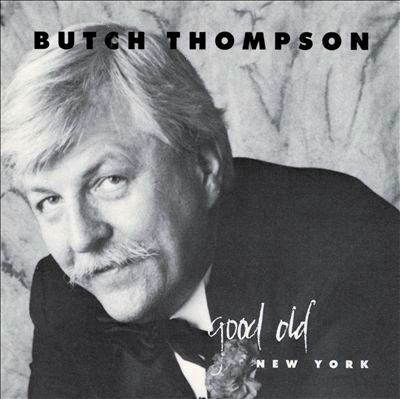 Through that show, and a series of subsequent albums, Thompson covered most of Morton's material using an approach that can be called organic, clean, and when necessary, very sparse. Very few could do what Butch can with so few notes played so elegantly, while capturing Morton's spirit in a way that captivates the listener. Another fine interpreter of his work, as well as an important researcher of aspects of Morton's life as well as his peers, is Dr. Robert Pinsker, who is also a fine interpreter of the works of Morton's contemporary, James P. Johnson.
Through that show, and a series of subsequent albums, Thompson covered most of Morton's material using an approach that can be called organic, clean, and when necessary, very sparse. Very few could do what Butch can with so few notes played so elegantly, while capturing Morton's spirit in a way that captivates the listener. Another fine interpreter of his work, as well as an important researcher of aspects of Morton's life as well as his peers, is Dr. Robert Pinsker, who is also a fine interpreter of the works of Morton's contemporary, James P. Johnson.
 Through that show, and a series of subsequent albums, Thompson covered most of Morton's material using an approach that can be called organic, clean, and when necessary, very sparse. Very few could do what Butch can with so few notes played so elegantly, while capturing Morton's spirit in a way that captivates the listener. Another fine interpreter of his work, as well as an important researcher of aspects of Morton's life as well as his peers, is Dr. Robert Pinsker, who is also a fine interpreter of the works of Morton's contemporary, James P. Johnson.
Through that show, and a series of subsequent albums, Thompson covered most of Morton's material using an approach that can be called organic, clean, and when necessary, very sparse. Very few could do what Butch can with so few notes played so elegantly, while capturing Morton's spirit in a way that captivates the listener. Another fine interpreter of his work, as well as an important researcher of aspects of Morton's life as well as his peers, is Dr. Robert Pinsker, who is also a fine interpreter of the works of Morton's contemporary, James P. Johnson.Another notable appearance of Morton's character was in the 1998 feature film The Legend of 1900 about a boy who was born on an ocean liner in the year 1900, spending his entire life on that ship as their pianist. The story is based on the book Novecento by Alessandro Baricco, who actually includes a great deal of Morton's presence in the original story. In the film over time 1900, as he is called, grows a reputation as perhaps the finest on the water, if not the land. In a pivotal scene, Morton (as ironically played by Clarence Williams III, grandson of composer Clarence Williams who was not particularly a fan of Morton's) comes aboard the ship and challenges the pianist to a duel. Both Morton's arrogance and his vivacious playing come across in a very engaging manner at the very least in the scene, as does his dejection [spoiler alert] at being bested by a supposed nobody. Still, it was an homage to the past master.
In the 21st century, the music of Jelly Roll Morton is routinely played at ragtime festivals and traditional jazz festivals, and is heard from pianists as diverse as Jeff Barnhart, Brian Holland, Bill Edwards, and even the group that has been referred to as the "Young Turks," which includes Adam Swanson, Andrew Barrett, Vincent Johnson, and especially Canadian force of Nature, Max Keenlyside, as well as countless others. It is clear the influence that Morton had on his peers, even when tempered with a more factual look at his real life verses his self-improved legend, remains with us, and is likely to for decades and even centuries to come. And in the end, that's pretty much what he had hoped for, albeit during his lifetime. So continues the saga of Ferdinand "Jelly Roll" Morton of New Orleans.
Even though this is a somewhat detailed encapsulation of Morton's life, which was peripheral to ragtime in many respects, there are many fine sources that drill down much deeper into his chronology, activities, relations and acquaintances. This story was assembled with original research by the author, often checking against or refuting certain information found in Alan Lomax's book Mister Jelly Roll, and the LoC recordings.
However, it was also helped along greatly with the extraordinarily detailed website of (the late) Mike Meddings, www.doctorjazz.co.uk. Several people in addition to Mike made this the go-to source for information on Morton and his peers, including (and not all of them are here, but will be found on the site) Professor Lawrence Gushee, Dr. Robert Pinsker, Professor James Dapogny, my friend the late Mike Montgomery, Peter Hanley (who contributed very detailed research on a wide range of Morton topics), the late Laurie Wright, Dr. Edward Berlin, the late Floyd Levin, Roger Richard, Butch Thompson, Ate van Delden, Dr. Philip Pastras, and many others. For their efforts we should be thankful that an accurate accounting of Morton's life, like the one assembled here, is even possible. They have managed to cut through the hyperbole and occasional nonsense to set the record straight on the life of this enigmatic piano genius.